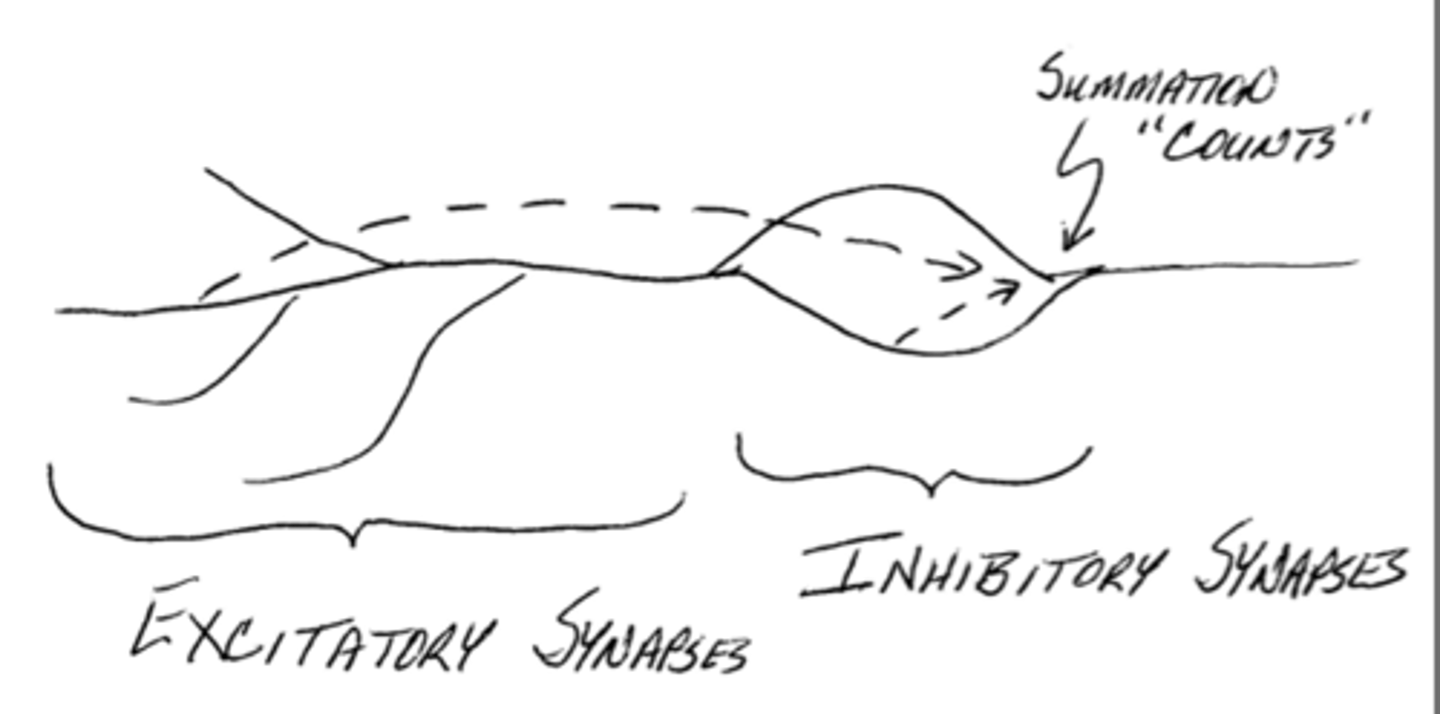1. nerve conduction & synaptic transmission
1/67
There's no tags or description
Looks like no tags are added yet.
Name | Mastery | Learn | Test | Matching | Spaced |
|---|
No study sessions yet.
68 Terms
why is the inside of cells negatively charged?
due to proteins and other negatively-charged macromolecule not found on the outside of the cell
why does potassium want to leave the cell if it is positively charged like sodium which wants to enter the cell?
potassium has a greater concentration force than electrical force making it want to follow the concentration gradient out of the cell; sodium has an electrical and concentration force into the cell
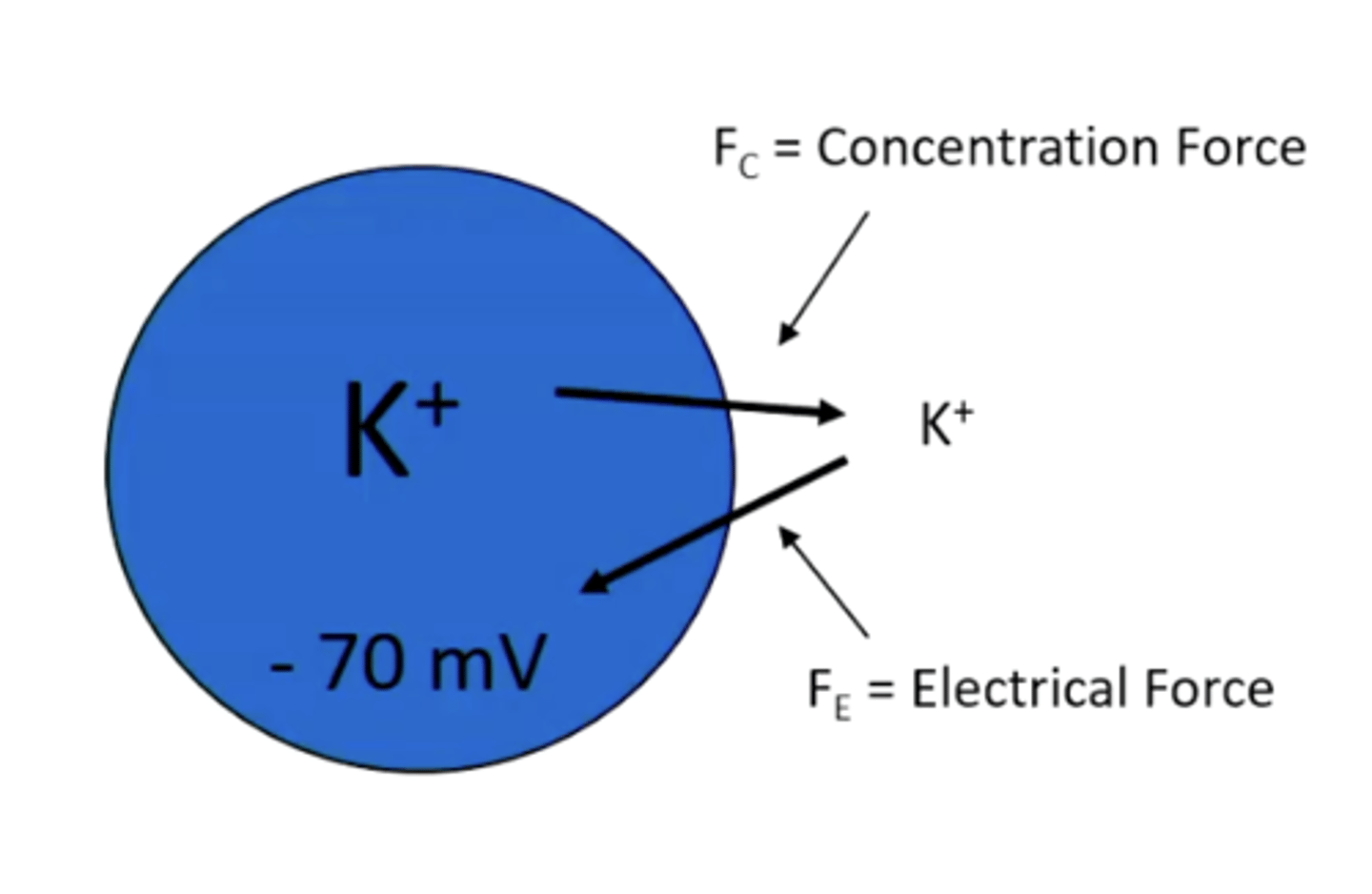
what are the Nernst potentials for sodium and potassium?
sodium = +70 mV
potassium = -94 mV

what does the Goldman equation state?
the membrane potential of a cell will always most closely resemble the Nernst Potential of the most permeable ion;
this is why a cell's membrane potential at rest is closer to potassium's Nernst Potential instead of sodium's
(t/f) changes in membrane permeability occurs by opening and closing voltage-gated channels in the cell membrane
true
what are 2 reasons as to why sodium movement predominates and is faster during depolarization than potassium movement?
1. there is a much larger driving force for sodium (moves more rapidly)
2. the potassium channels open more slowly than do the sodium channels (rise in potassium permeability develops slowly)
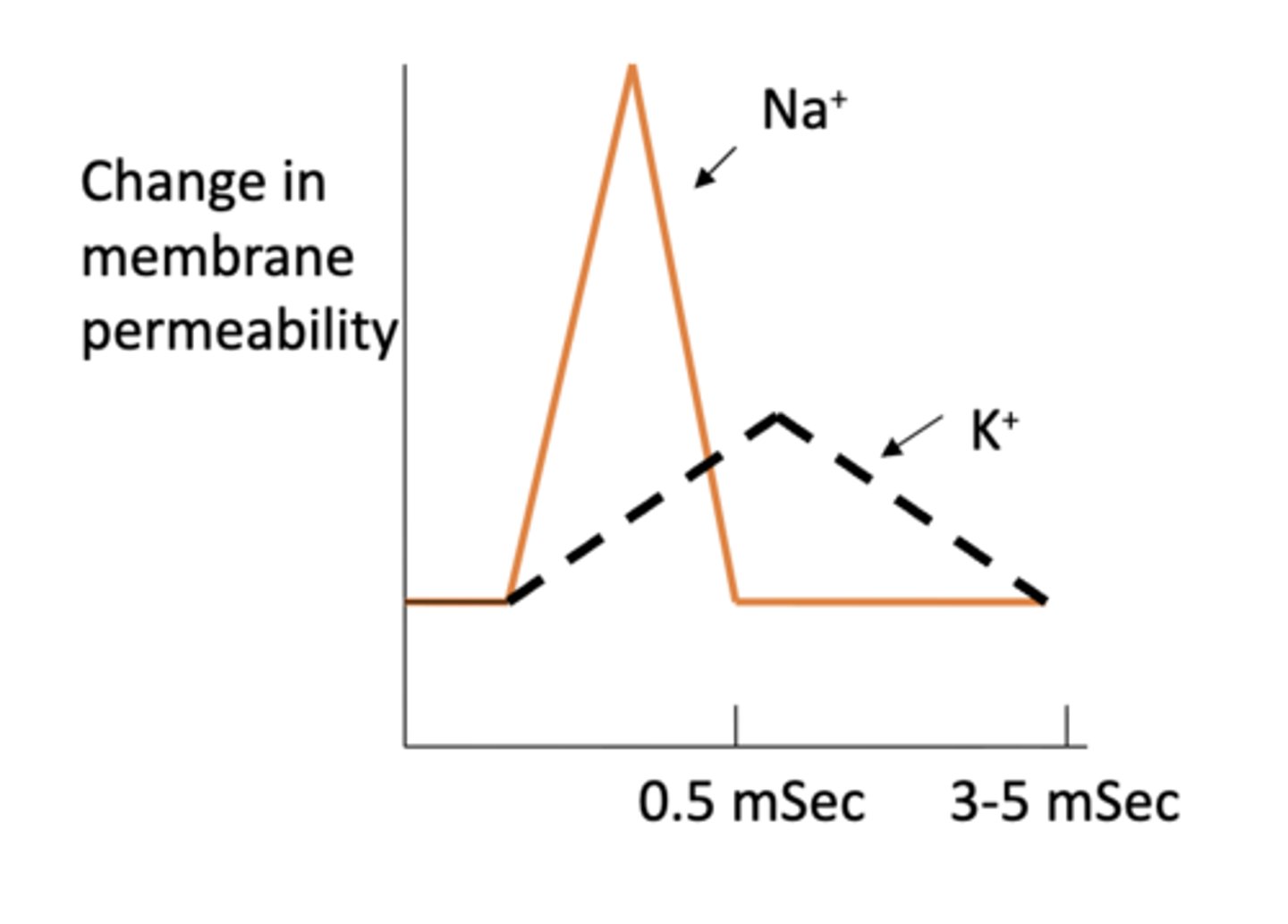
what are the 5 components of the sodium-gated channel?
1. activation gate
2. inactivation gate
3. conductance pore
4. selectivity filter
5. voltage sensor
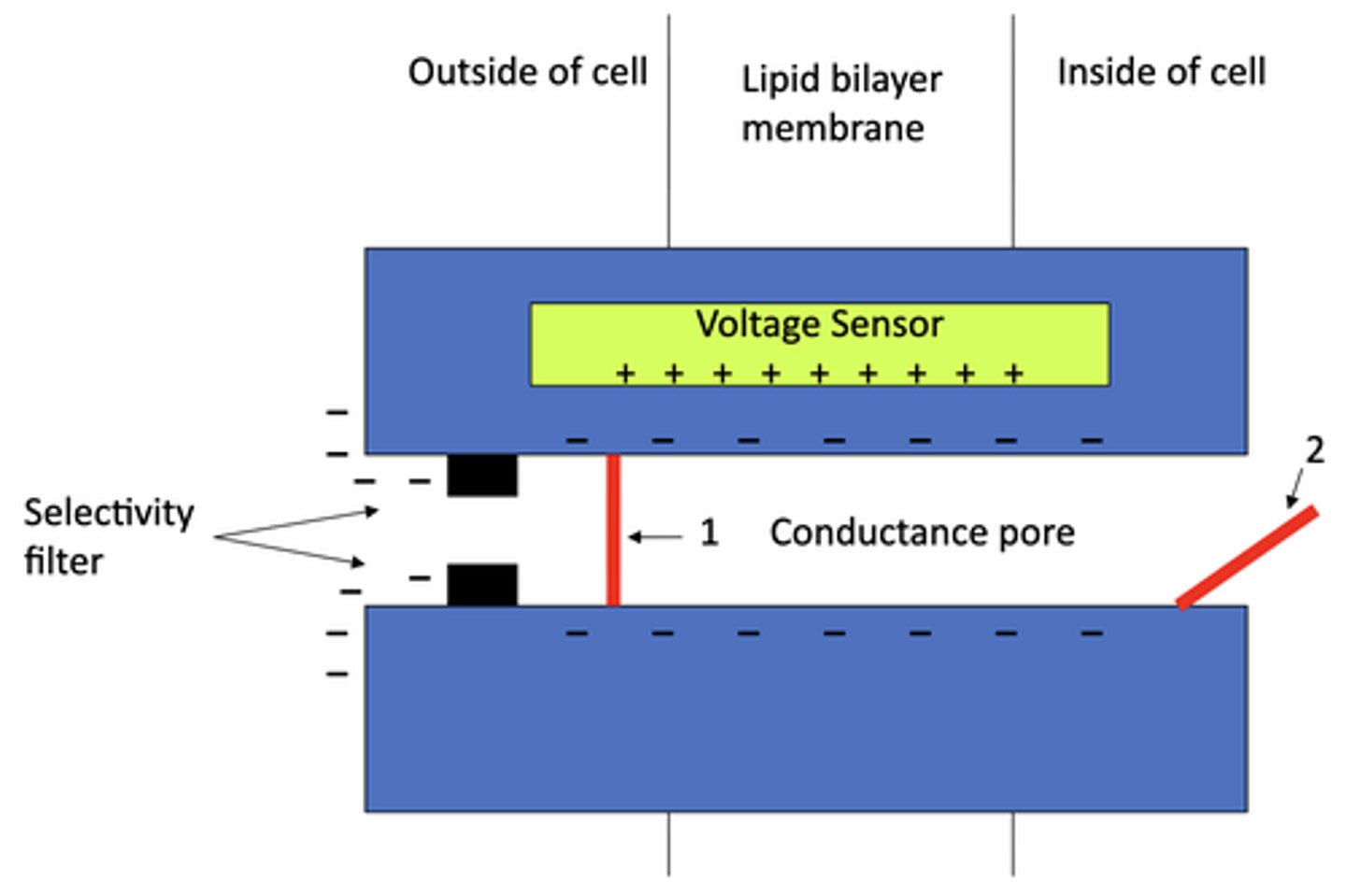
what are the 4 components of the potassium-gated channel?
1. a single gate (sodium has 2)
2. conductance pore
3. selectivity filter
4. voltage sensor
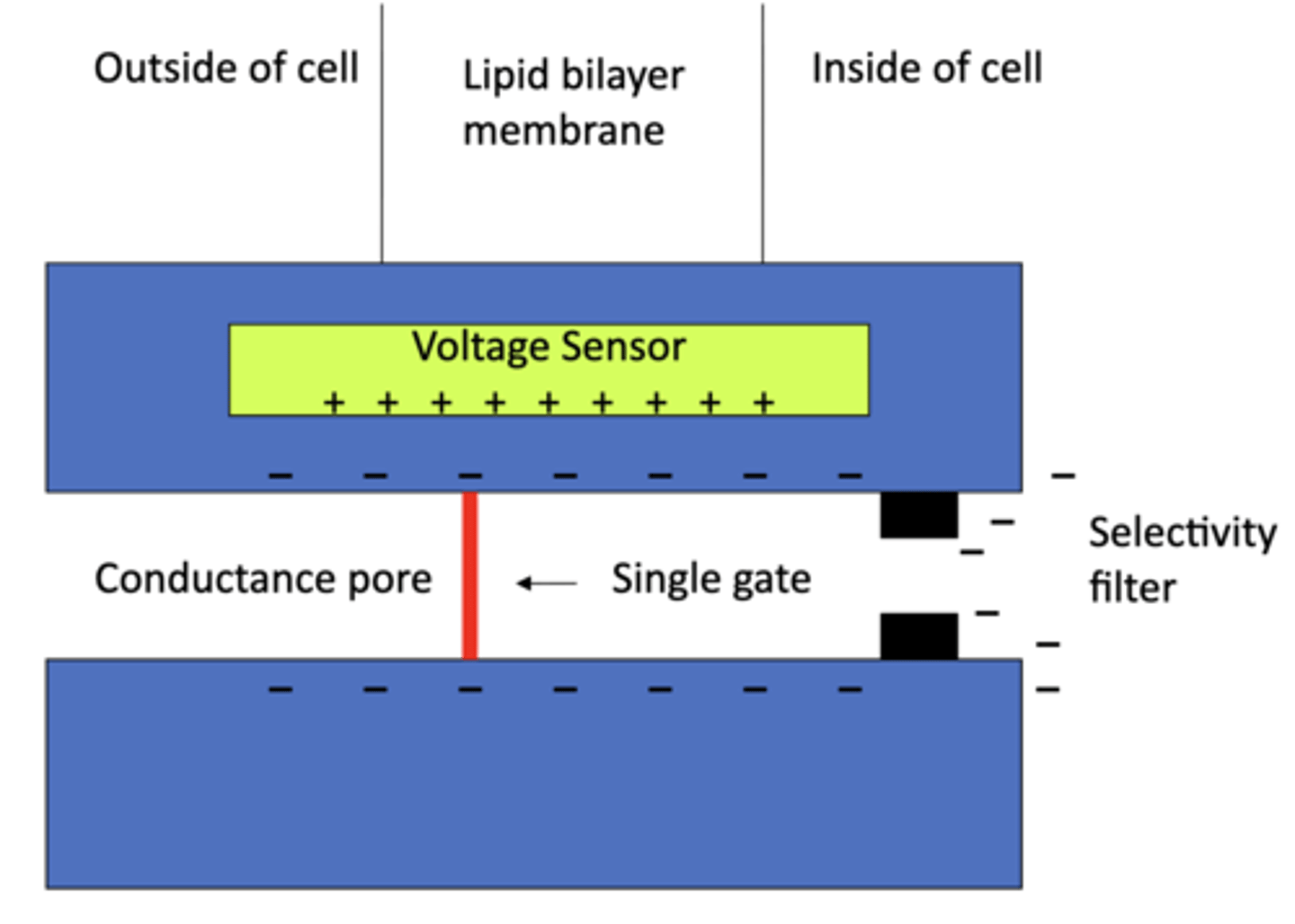
what would happen if the current flow is too low or too brief in duration?
the sodium channel gates cannot open and no action potential will be produced
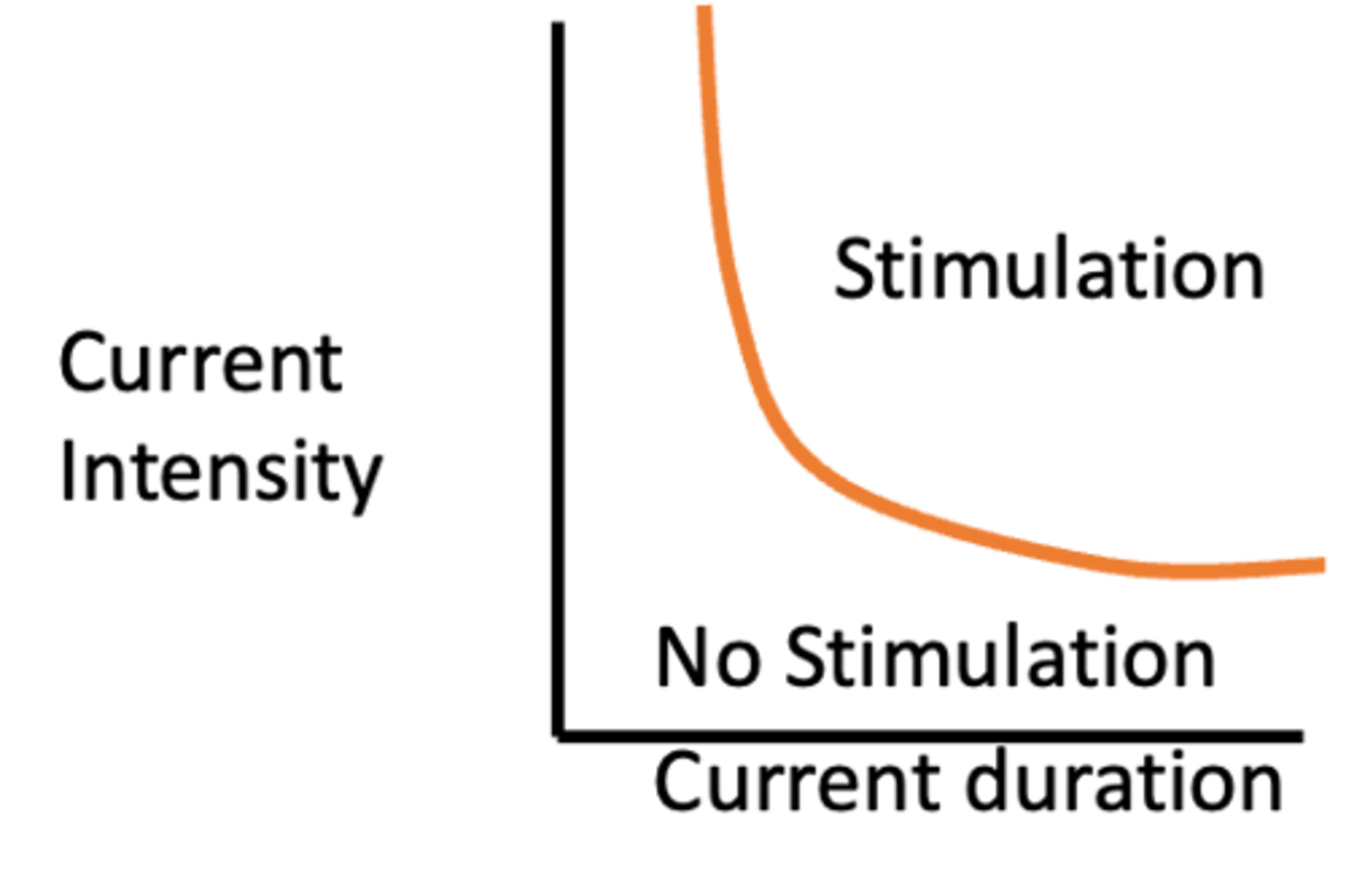
what is electrocautery?
high intensity, but short duration pulses are applied to a tissue to destroy it without stimulating it; no action potentials are produced from the brief pulses, the tissue will not twitch
what are the 2 directions that an action potential can travel down along an axon?
1. antidromic: action potential toward the cell body
2. orthodromic: action potential toward the axon terminal

why isn't the action potential lost as it moves along the membrane if there is a leakage of the positive charge across the membrane?
the action potential is regenerated as it moves along the axon due to voltage-gated sodium and potassium channels; the action potential ends up depolarizing the newly occupied piece of membrane and gets back to it's original level of depolarization

what is a consequence of an action potential needing to regenerate itself as it moves down the axon? how are 2 ways to solve this?
decreased speed as a brief pause must occur while the sodium channels open;
1. increase the diameter of the axon
2. myelination
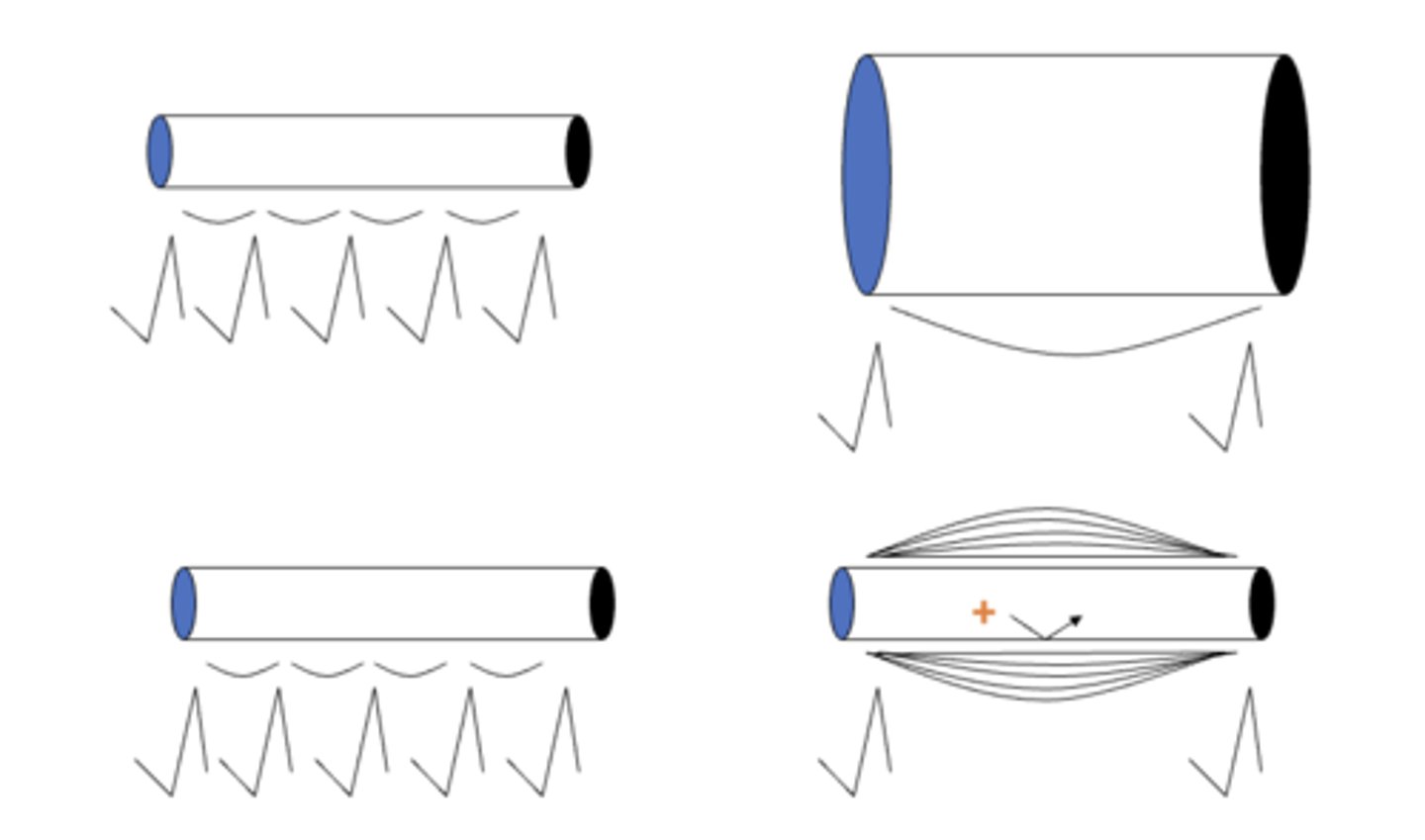
how does an increase in axon diameter affect action potential?
decreases resistance so the action potential moves more rapidly with less need for pause and regeneration (compared to a smaller diameter)
what can be done to an axon to reduce the short-circuiting across the membrane?
myelination
what term refers to the multiple wrappings of glial cell membrane around the axon that act like an insulation along an electrical wire?
myelination
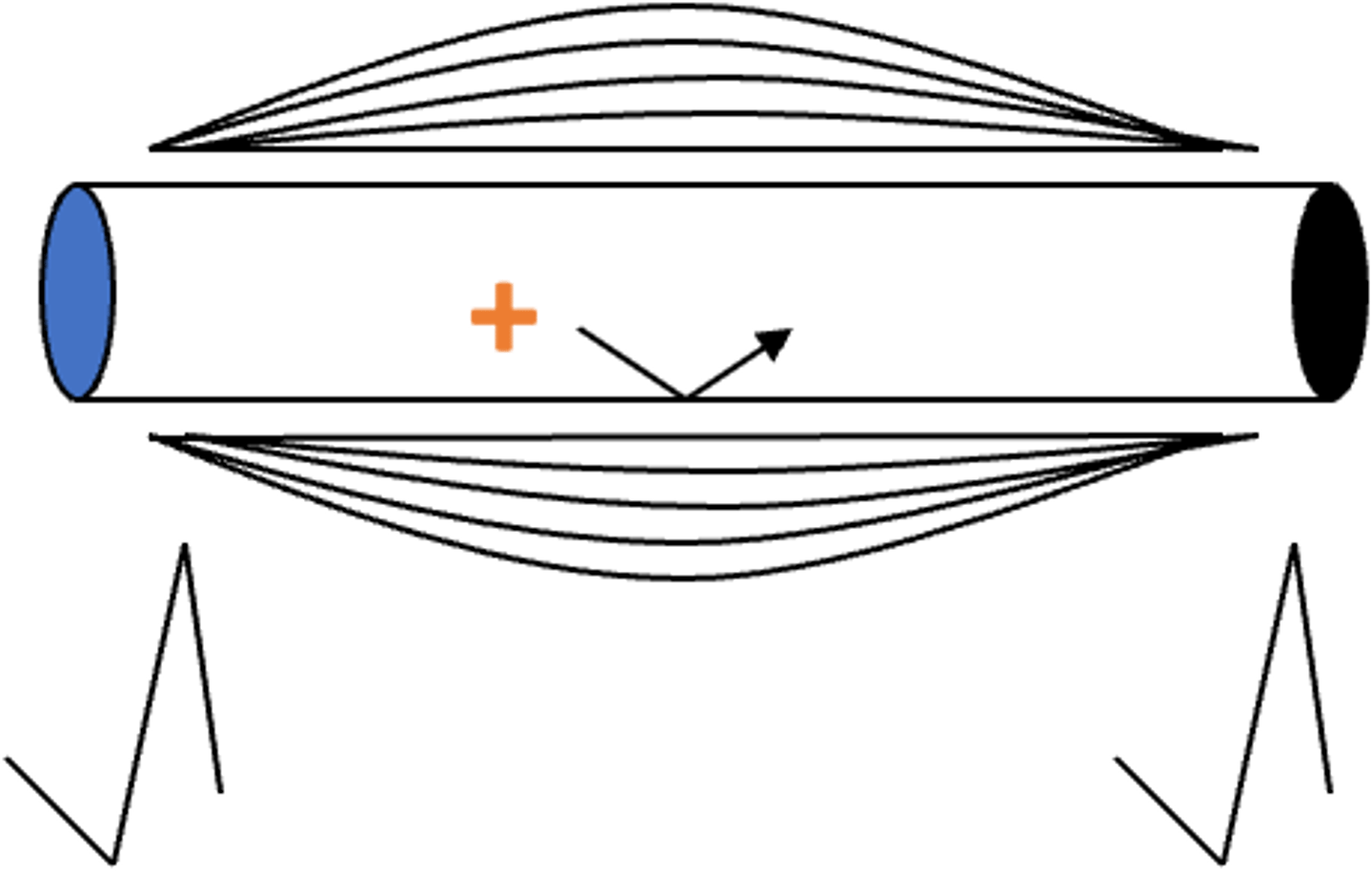
(t/f) the cytoplasm of glial cells that form the myelin sheath is what insulates the axon
false; the lipid bilayer of glial cells that form the myelin sheath is what insulates the axon
what are the myelinating glial cells in the peripheral nervous system called?
schwann cells
what are the myelinating glial cells in the central nervous system called?
oligodendrocytes
(t/f) myelination still requires that there is an increase in diameter because of how thick the glial cells are
false; myelination allows a rapid conduction without increasing axon diameter. this can be seen especially in the CNS where more axons are packed into the enclosed spaces of the cranium and spine
(t/f) the myelin sheath is continuous
false; the myelin sheath CANNOT be continuous because there is still current leak happening across the membrane. there has to be breaks containing voltage-gated sodium and potassium channels to regenerate the action potential
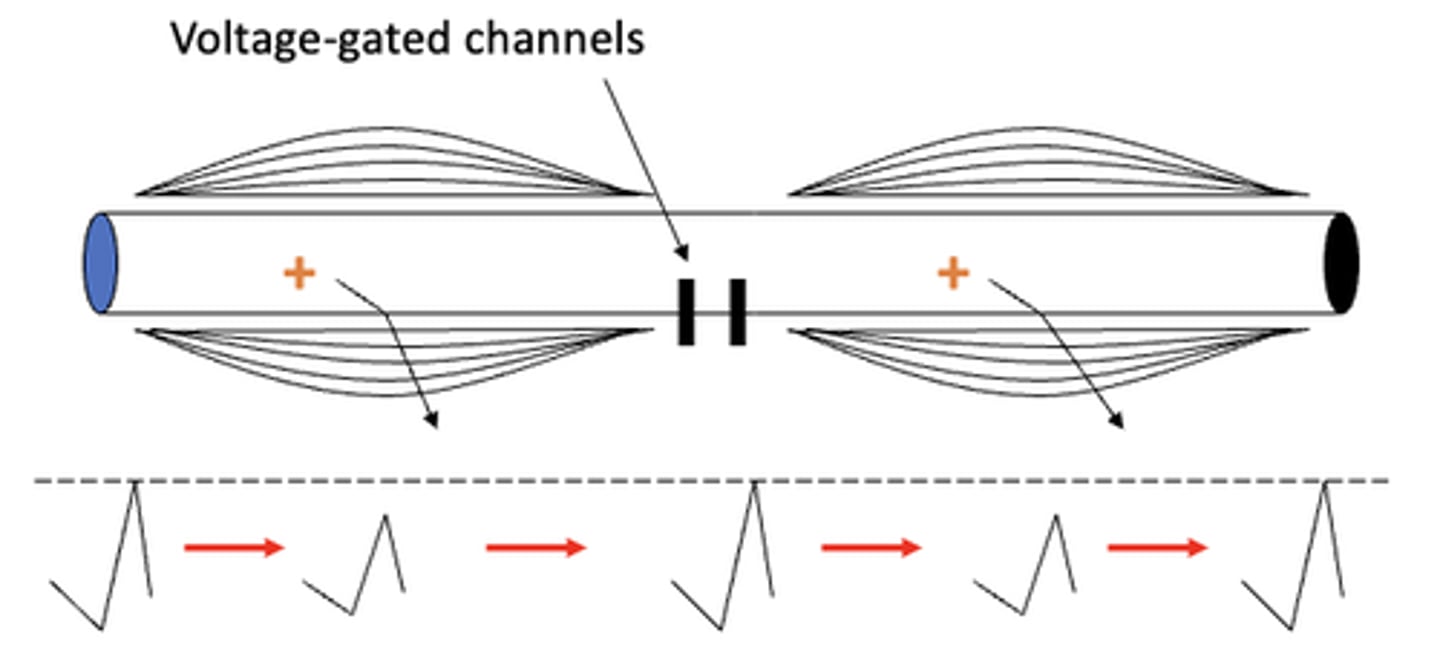
what are the breaks found between glial cells located every 1-2 mm along the axon?
Nodes of Ranvier
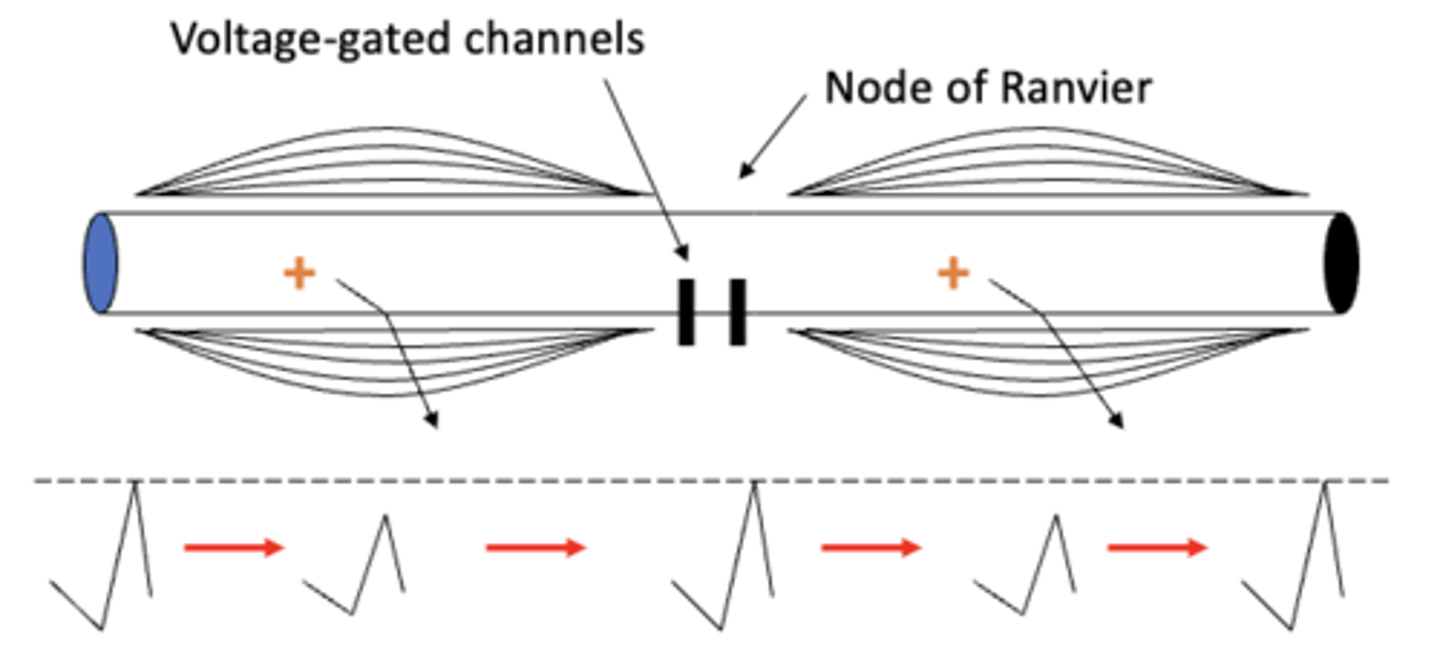
what is saltatory conduction?
the propagation of action potentials along myelinated axons from one Node of Ranvier to the next Node of Ranvier
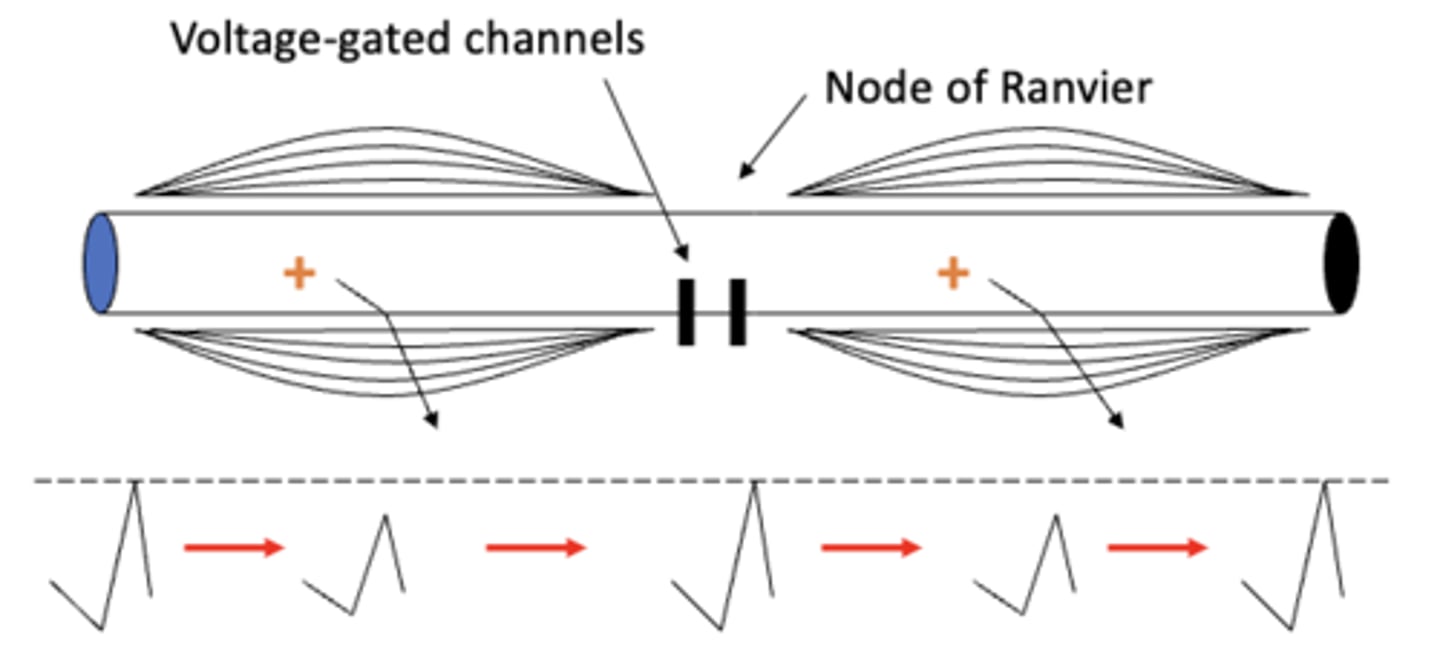
what kinds of disorders are multiple sclerosis and guillian-barre syndrome?
these are disorders of myelination
the (absolute/relative) refractory period prevents the reverberation of the action potential along the axon due to the closure of the (inactivation/activation) gates
absolute, inactivation
During the absolute refractory period, the voltage-gated Na⁺ channels are inactivated — their inactivation gates are closed. Because of this, no new action potential can be generated, even if the membrane depolarizes again. This ensures the action potential only moves forward along the axon and cannot bounce backward (no reverberation).
describe why action potentials are not reverberated along the axon
At each node (Node of Ranvier), the action potential is regenerated — new Na⁺ channels open, letting Na⁺ rush in and depolarize that segment.
Some current does flow backward (antidromically) toward the previous node.
However, the previous node’s Na⁺ channels are inactivated — their inactivation gates are still closed during the absolute refractory period, so another action potential cannot be triggered there.
The antidromic current continues a bit farther backward, but by the time it reaches a node that’s recovered enough (relative refractory period), the current is too weak to bring that node to threshold because much of the charge has leaked away.
As a result, the backward (antidromic) potential dies out, and the action potential can only move forward (orthodromically).
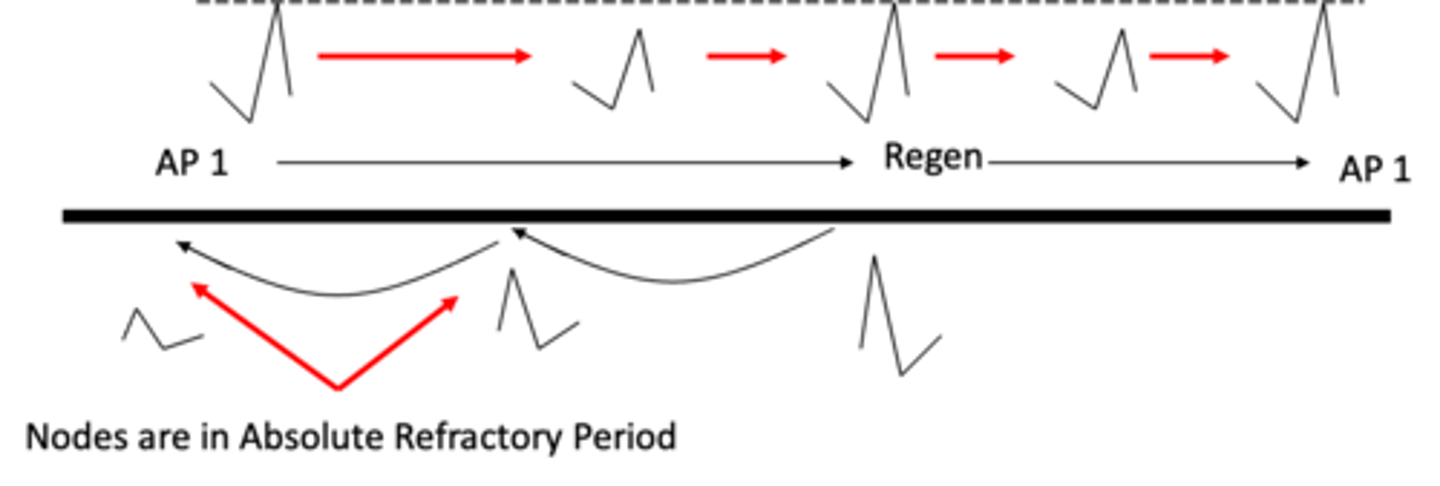
the (absolute/relative) refractory period sets the maximal discharge frequency of a neuron. how?
absolute;
during this phase, voltage-gated Na⁺ channels are inactivated immediately after opening. until they return to their resting state, no new action potential can be fired, no matter how strong the stimulus
the theoretical maximal frequency of a neuron discharge is _____-_____ impulses per second. what does this mean?
400-500; any stimulus above this cannot be encoded
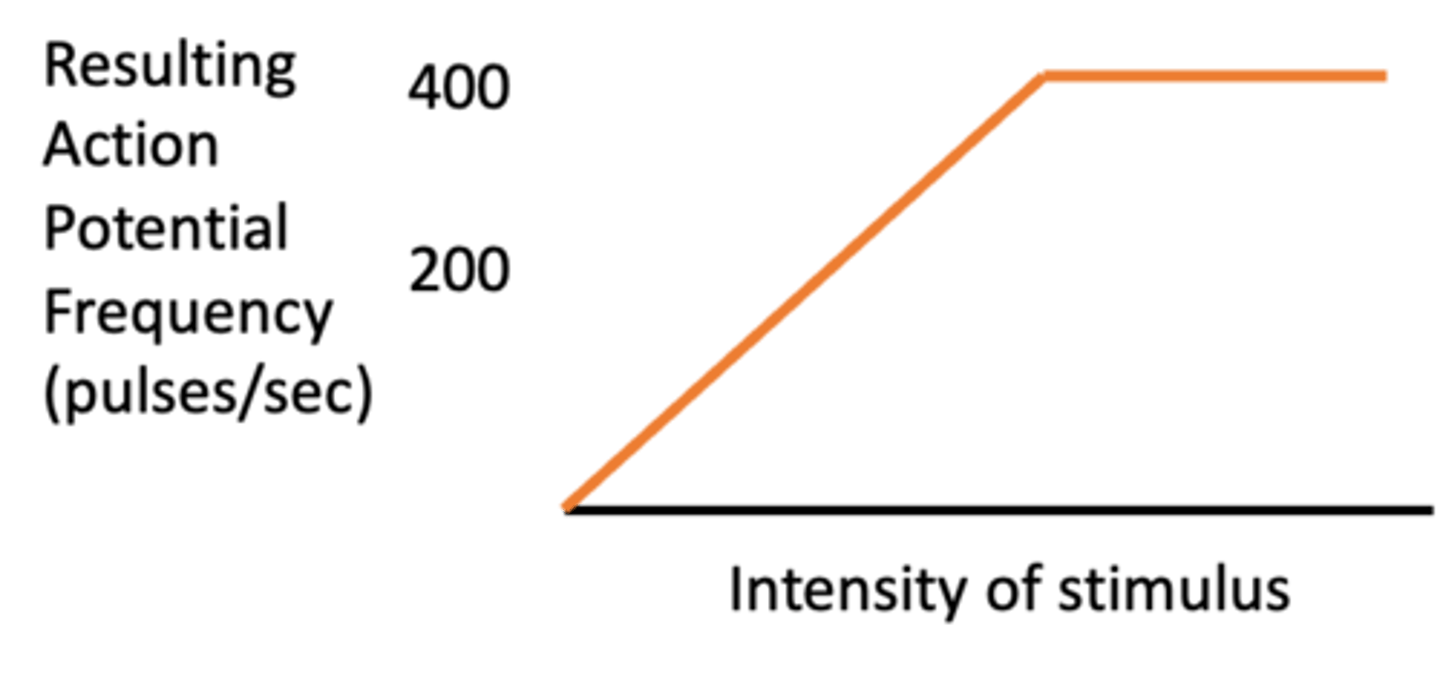
if the absolute refractory period ends about 2 mSec after the start of the action potential, then at the very earliest the next action potential could begin about ___ mSec after the previous action potential began
2
the job of neurons is to process and distribute information. all information is encoded in the form of a ___________ and __________ of action potential discharge.
frequency, pattern

(t/f) each individual neuron determines whether or not to generate an action potential only through the amount of EPSPs at the patch of cell membrane with the highest threshold
false; each individual neuron determines whether or not to generate an action potential through the summation of EPSPs and IPSPs at the patch of cell membrane with the lowest threshold
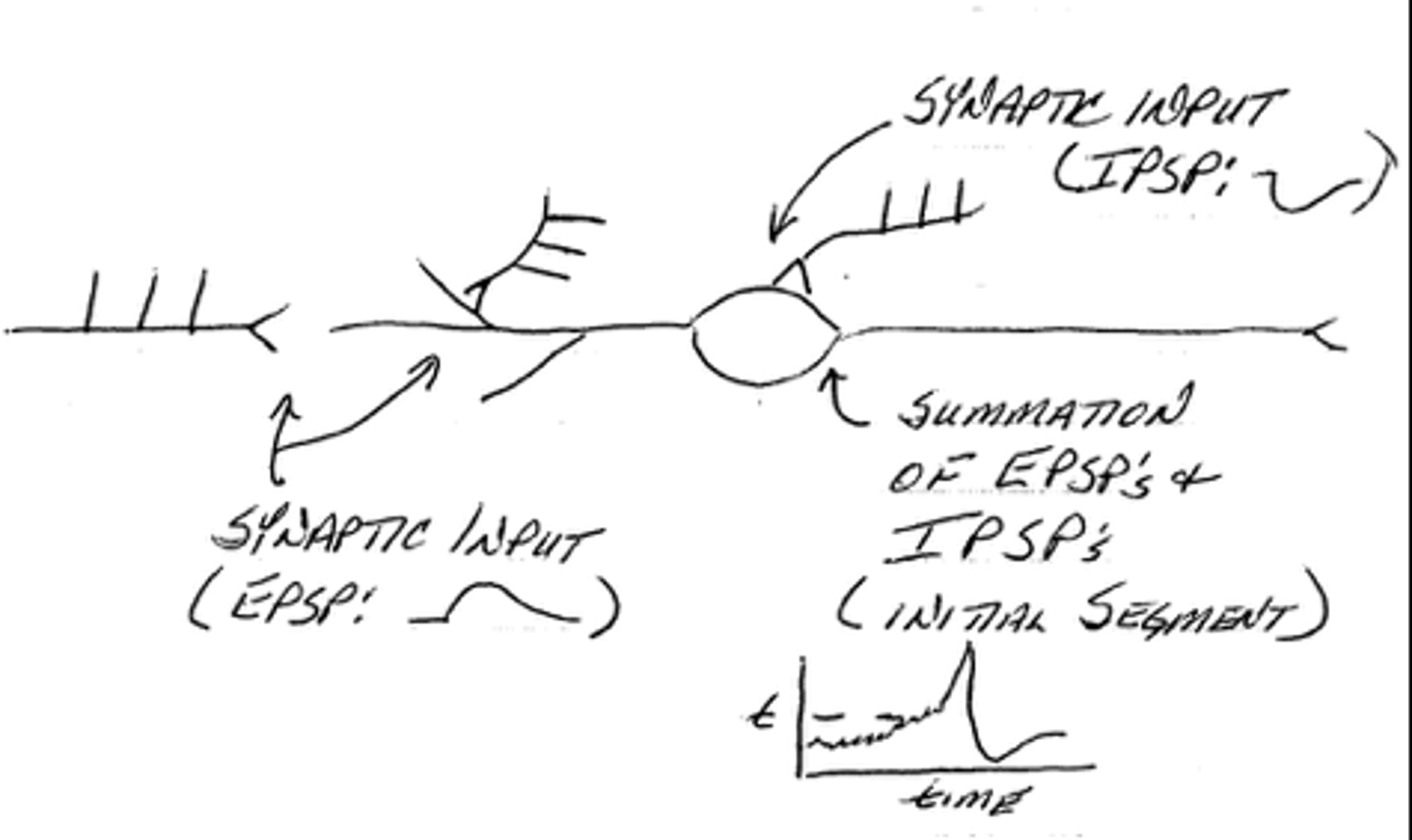
what part of the neuron most frequently has the lowest threshold for an action potential?
initial segment (axon hillock)
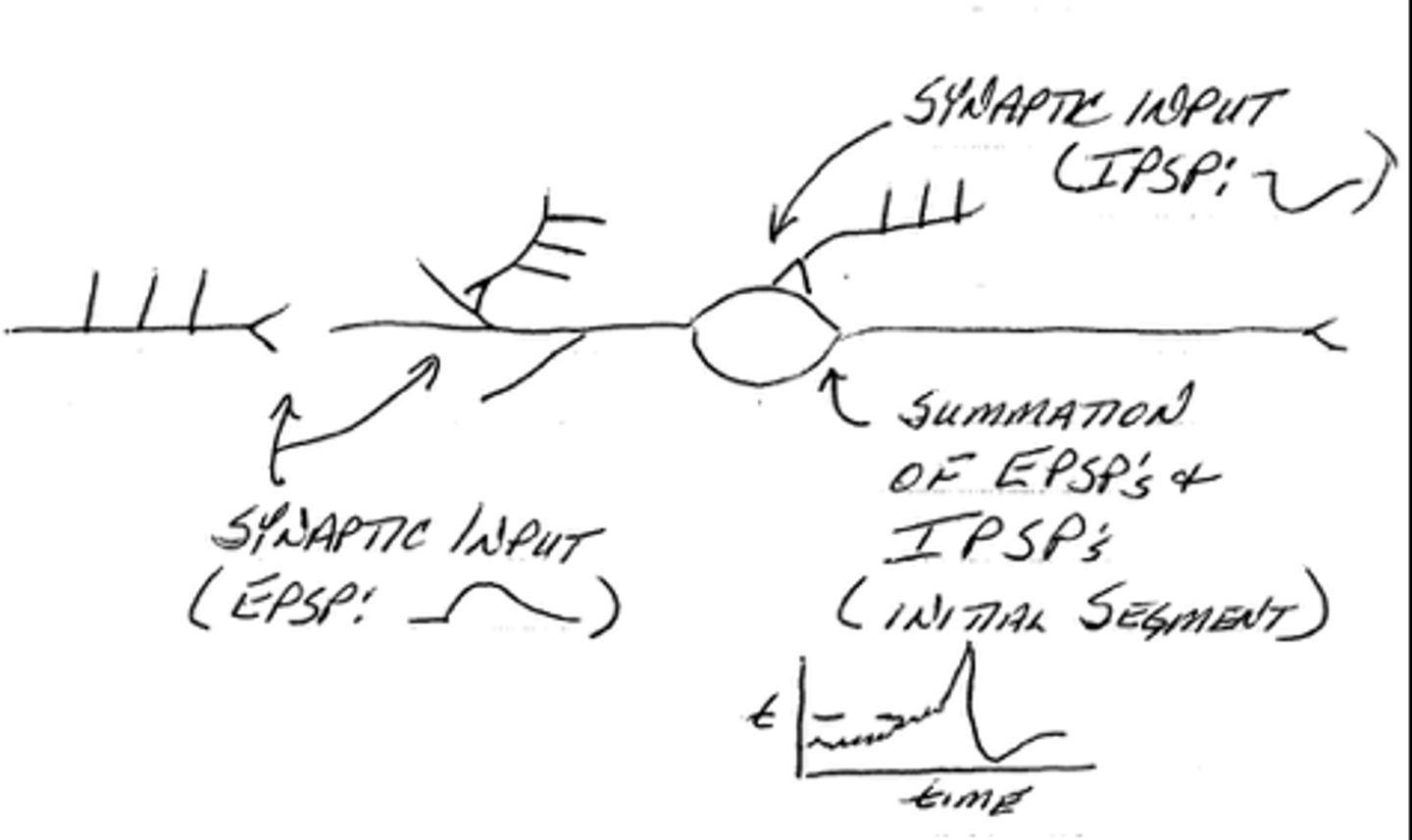
(t/f) EPSPs and IPSPs are generated depending on the strength of the action potential
false; EPSPs and IPSPs are generated depending on the release of excitatory or inhibitory neurotransmitters
Every action potential in the presynaptic neuron is all-or-none — it always has the same strength once threshold is reached.
What actually determines whether an EPSP or IPSP occurs is the type of neurotransmitter released and the type of receptor on the postsynaptic membrane.
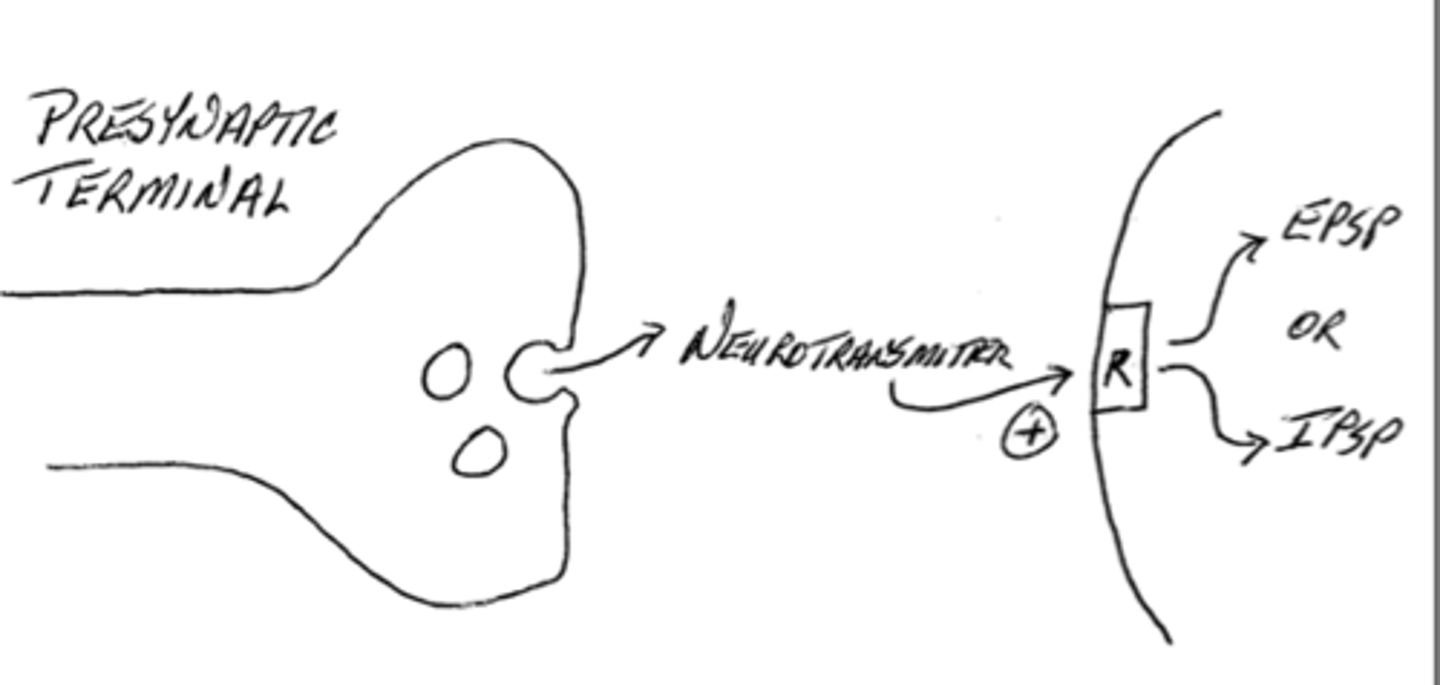
(t/f) presynaptic neurons synthesize their transmitter molecules as soon as the action potential arrives. these molecules cannot be stored because they are hydrophobic and would just pass through a vesicle.
false; a presynaptic neuron will synthesize and store its transmitter molecules ahead of time in vesicles called synaptic vesicles and this is possible because the molecules are hydrophilic
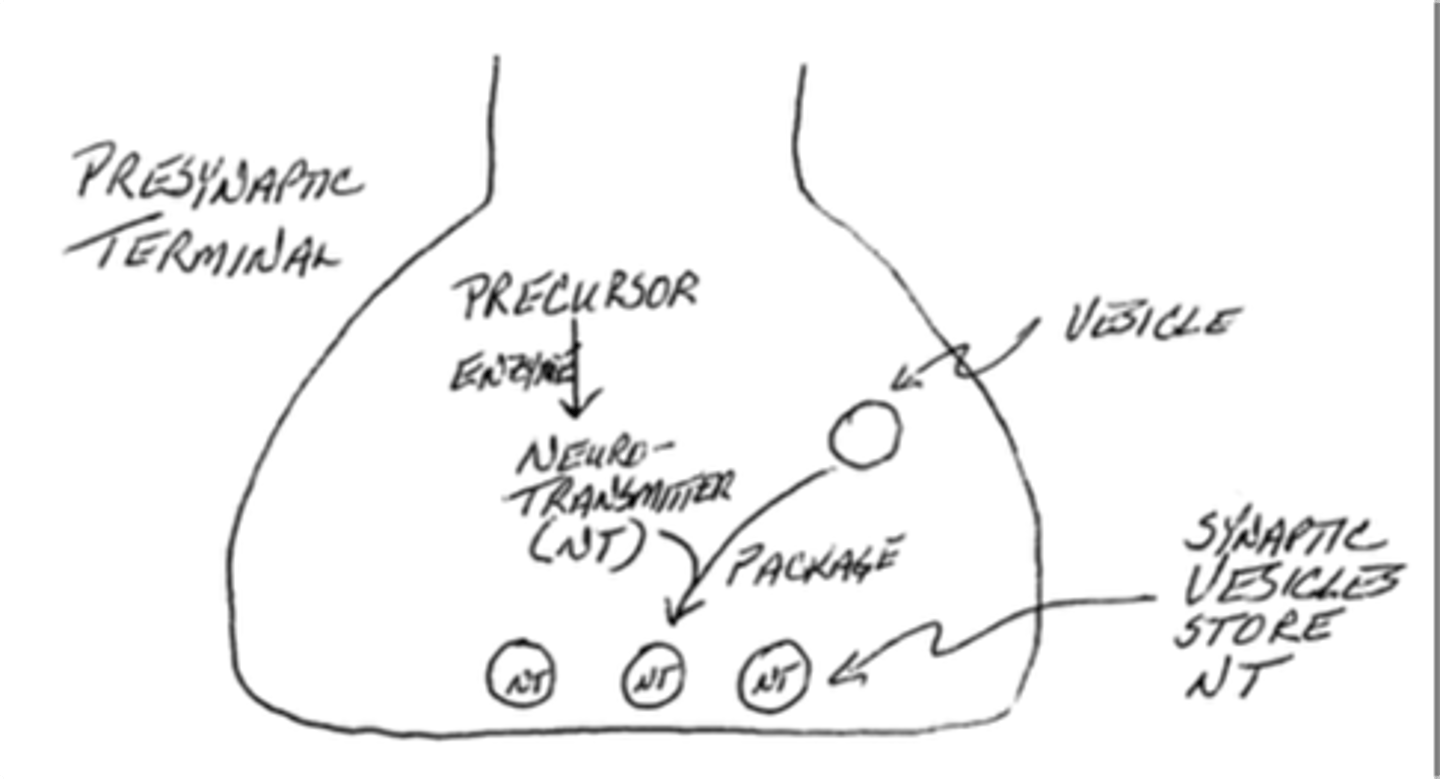
what causes a presynaptic neuron to release a neurotransmitter?
the arrival of the action potential triggers the release of the molecules from the vesicle into the synaptic cleft
A presynaptic neuron releases neurotransmitter when an action potential opens voltage-gated Ca²⁺ channels, allowing Ca²⁺ to enter and trigger vesicle exocytosis.
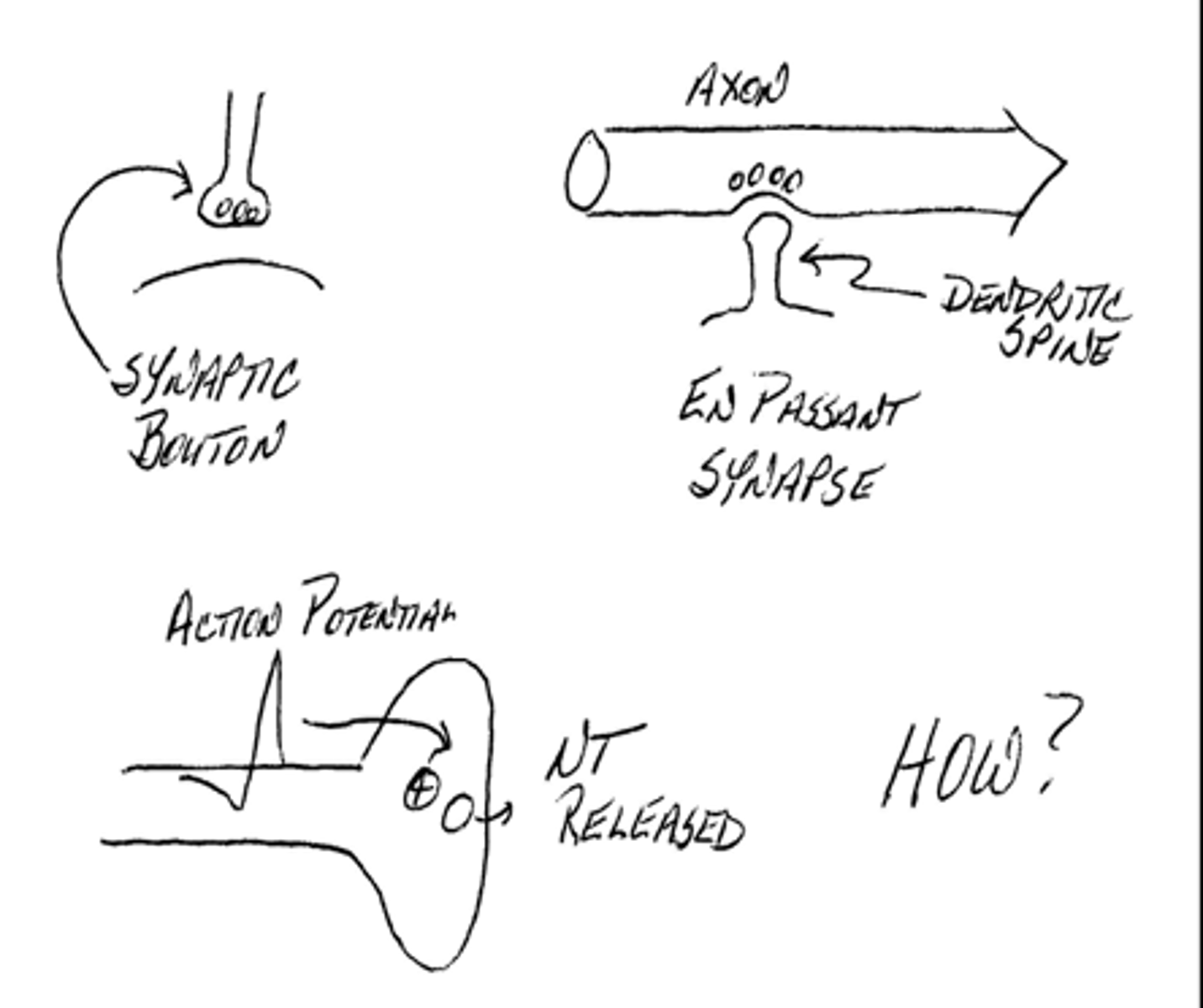
what structure traps the vesicles at the pre-synaptic terminal to keep them from leaving?
pre-synaptic density (a protein matrix)
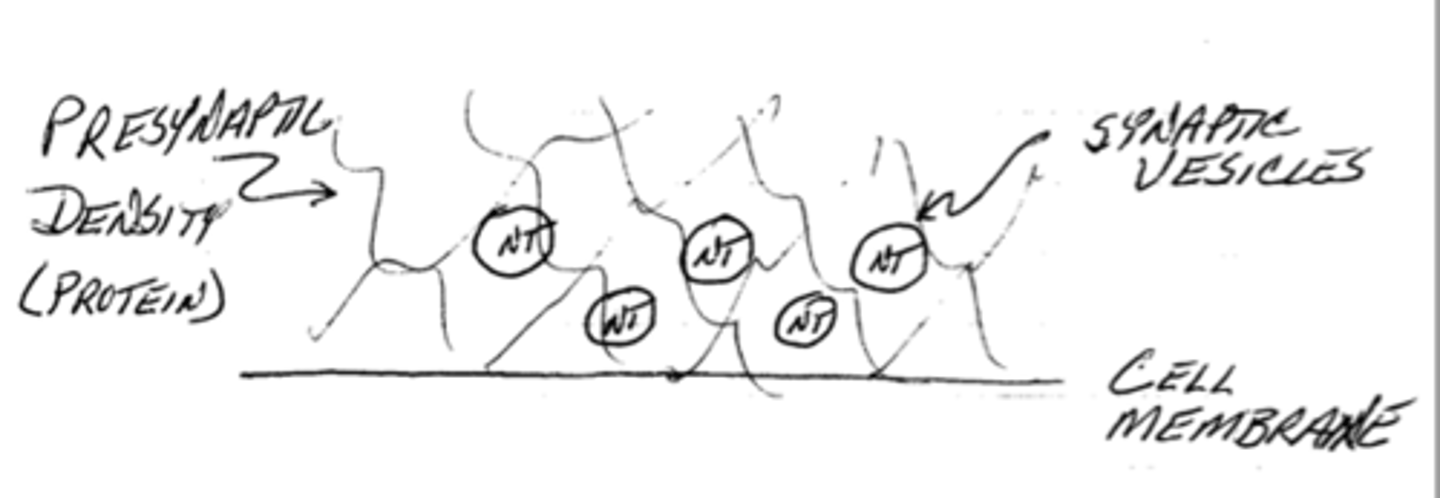
what 2 proteins make up the presynaptic density?
1. actin filaments: forms a thicket
2. synapsin I: forms the physical link connecting the vesicle to the actin filaments
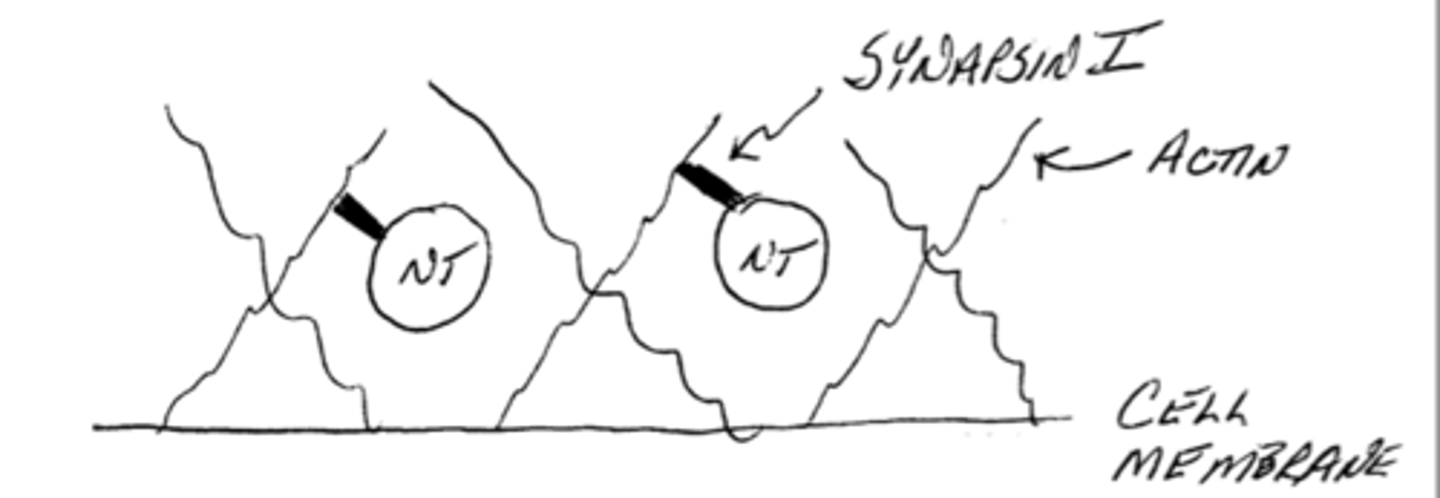
what is the structure that contains the appropriate receptors for sensing the presence of neurotransmitters and contains the effectors that will generate the post-synaptic response?
post-synaptic density
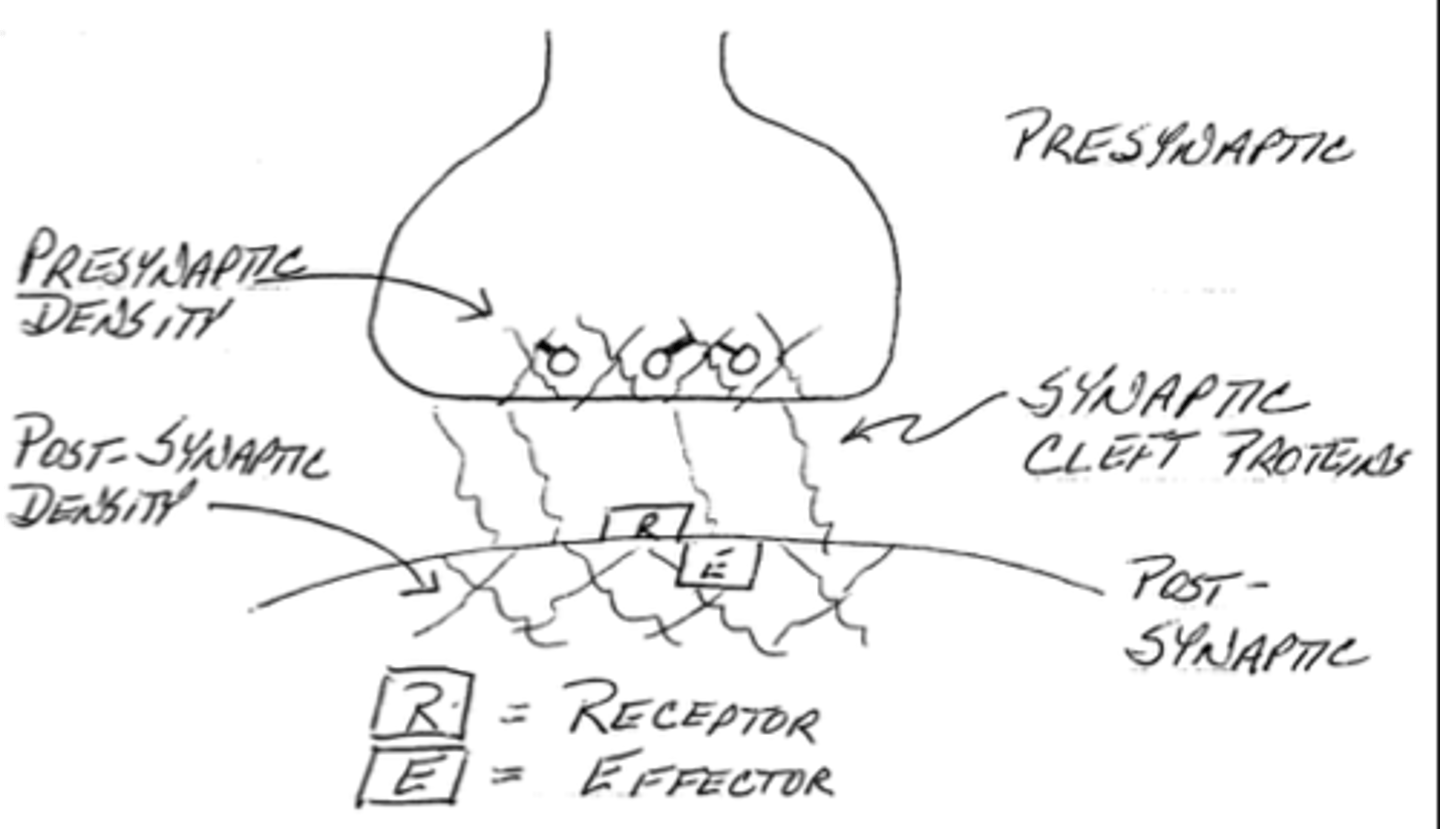
(t/f) the pre-synaptic density sits directly across from the post-synaptic density and may be joined by a protein matrix that transverses the synaptic cleft
true
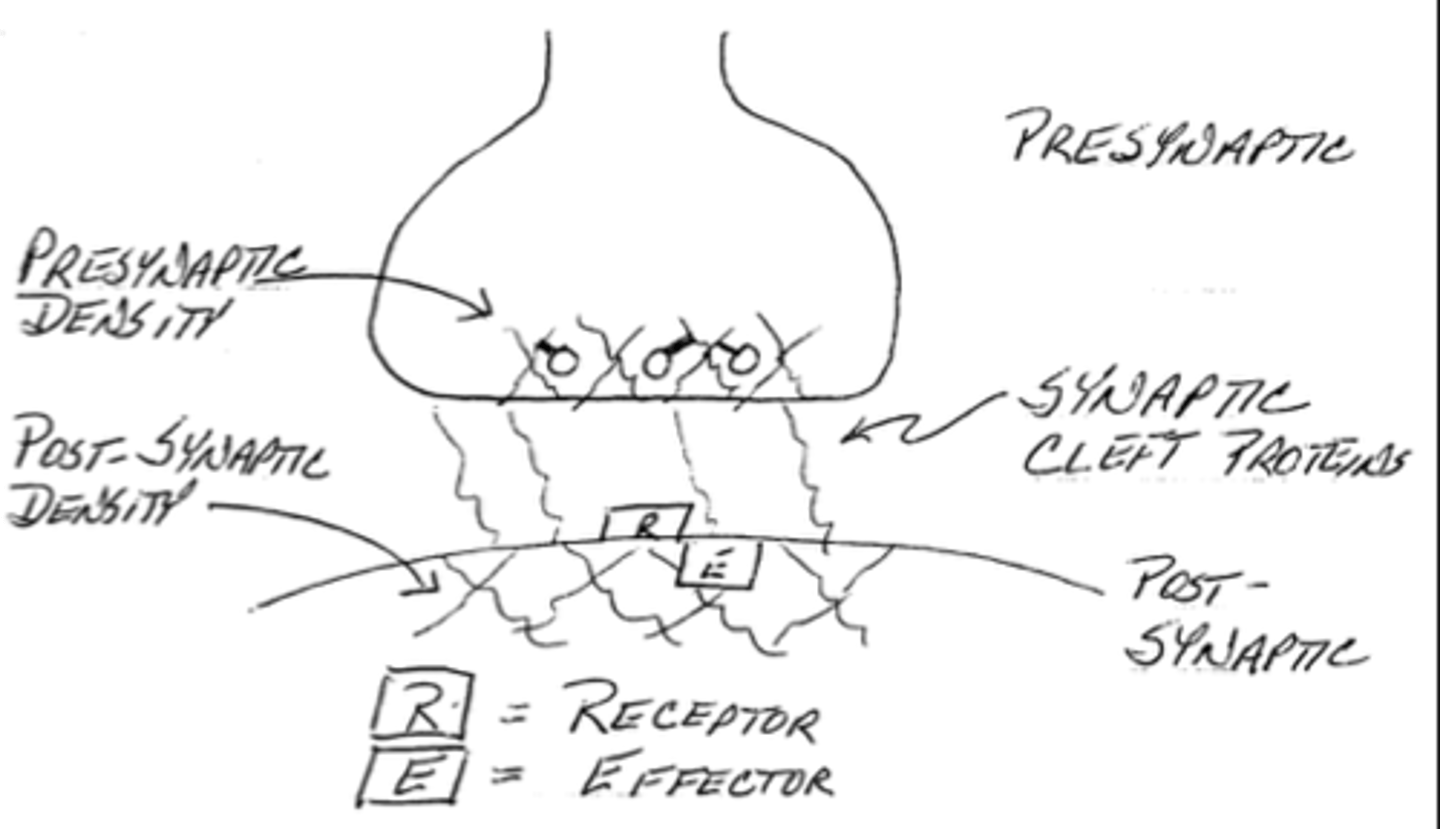
what causes the electrical event (action potential) to produce the subsequent physical event (content exocytosis of the synaptic vesicles)?
the action potential causes the opening of N-type voltage-gated calcium channels; this influx of calcium and increase in calcium permeability influences the release of the neurotransmitters
what are 3 proteins that calcium can bind to once it enters the presynaptic terminal?
1. calcineurin
2. calmodulin
3. SNARE proteins (synaptobrevin and syntaxin)
which calcium binding protein will cause the closure of recently opened calcium channels to terminate the increase in calcium concentration by causing the gradual pumping of calcium out of the neuron?
calcineurin
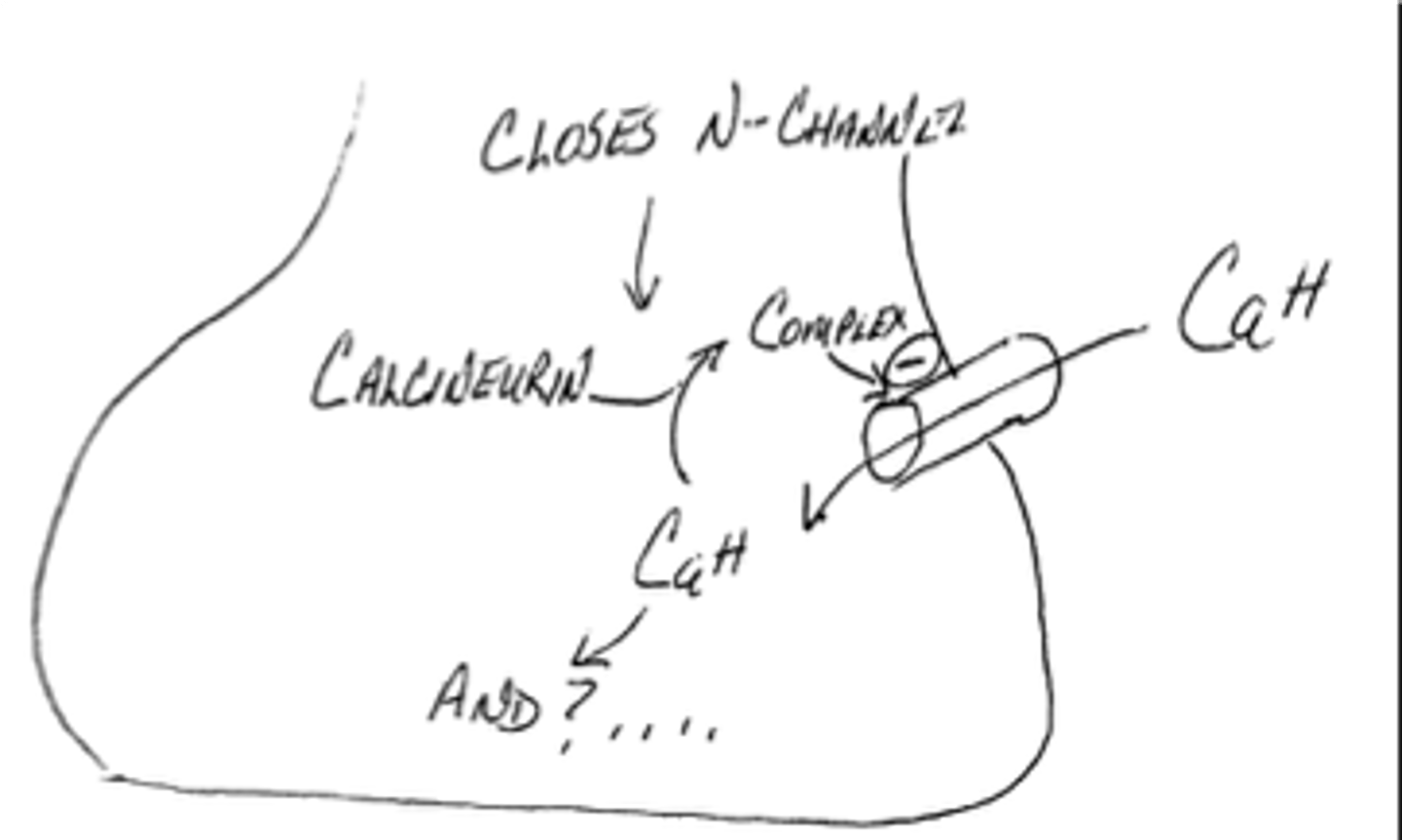
which calcium binding protein will bind to and activate CAM kinase II to phosphorylate the synapsin to allow the release of the vesicle bound to it and the clumping of the thicket of the presynaptic density?
calmodulin
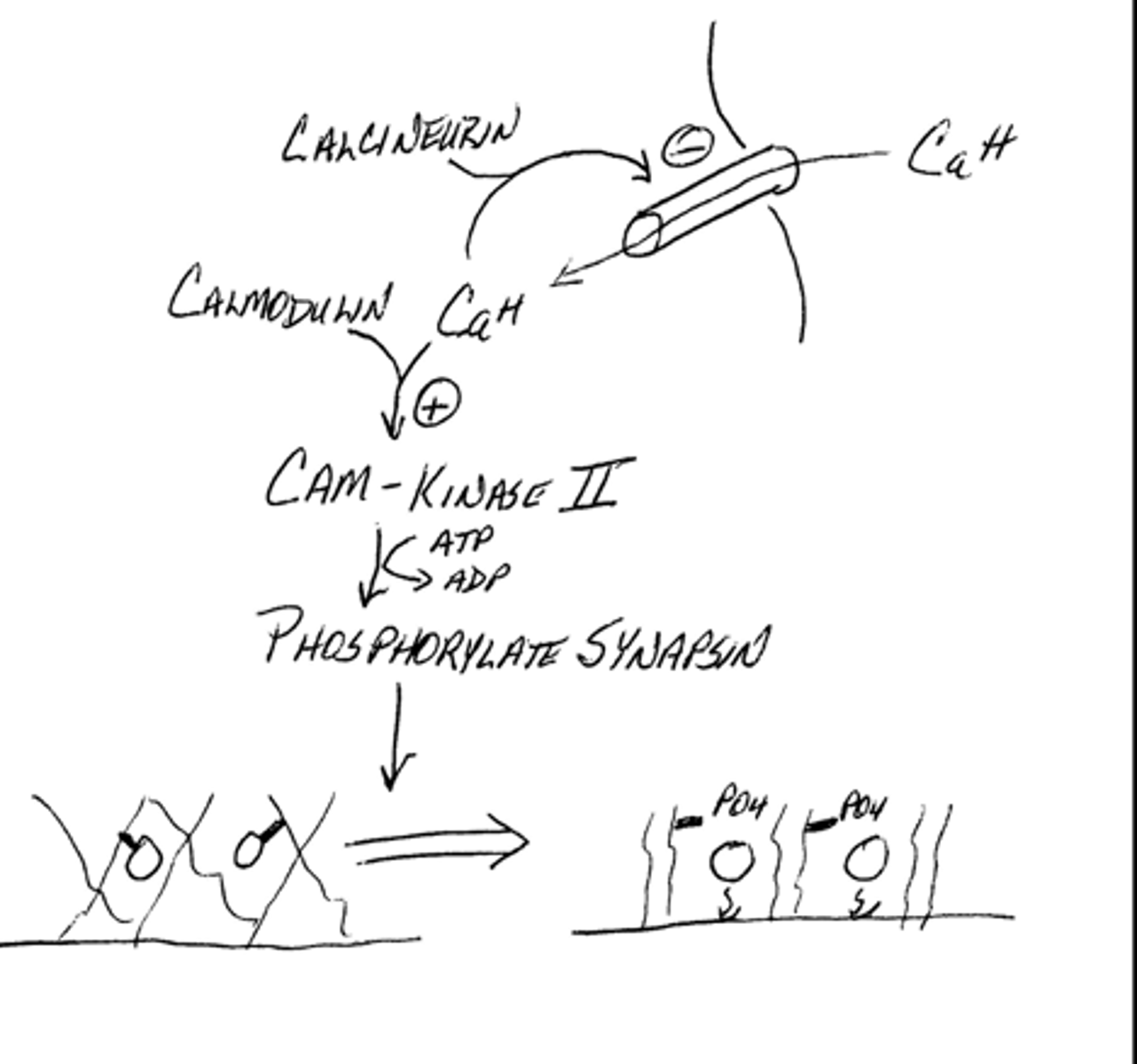
which calcium binding protein is an intramembranous protein that acts as a docking station to facilitate the fusion of the vesicle with the presynaptic membrane (for exocytosis)?
SNARE proteins (synaptobrevin and syntaxin)
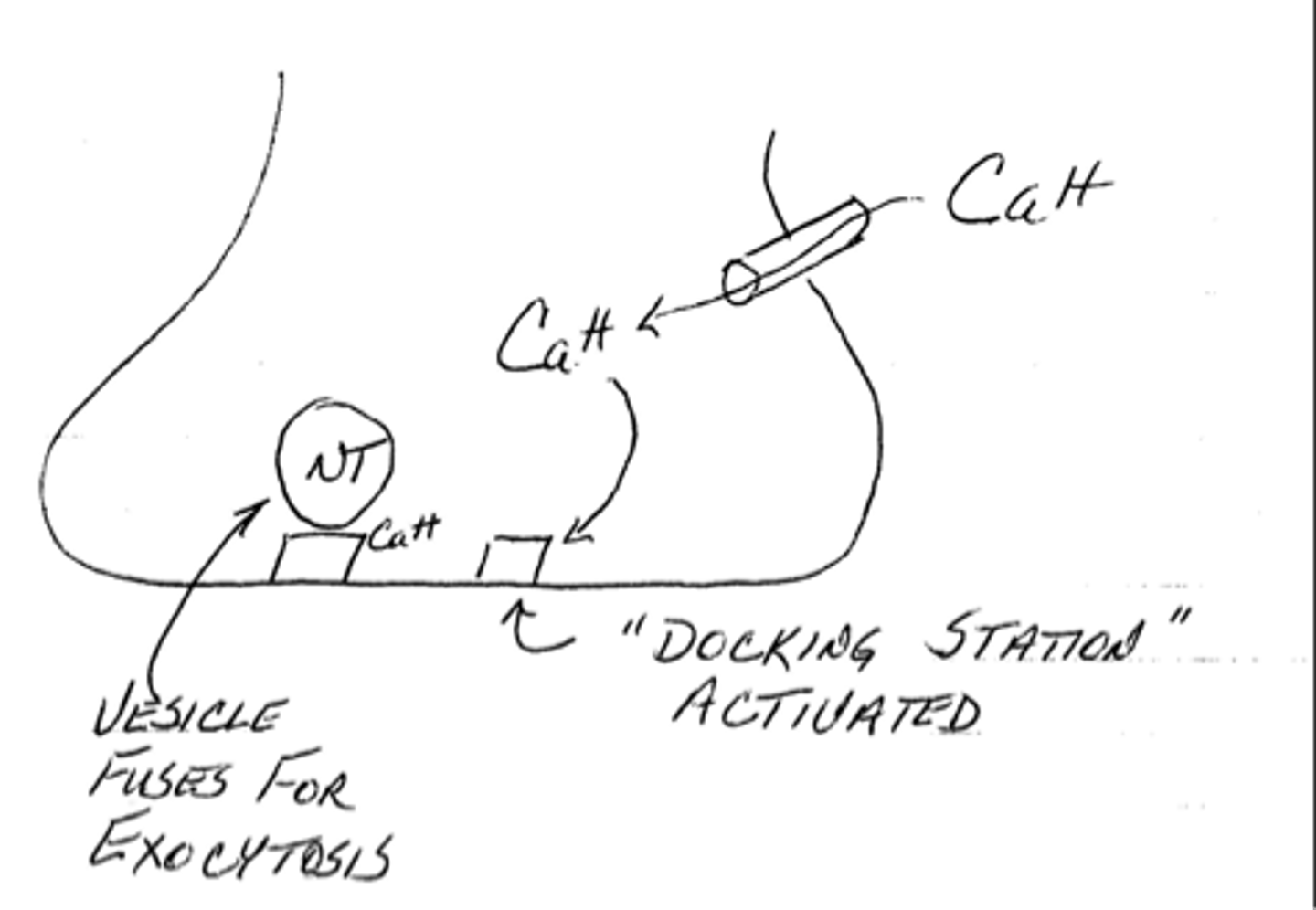
(t/f) there is no specific direction neurotransmitters diffuse in the synaptic cleft
true
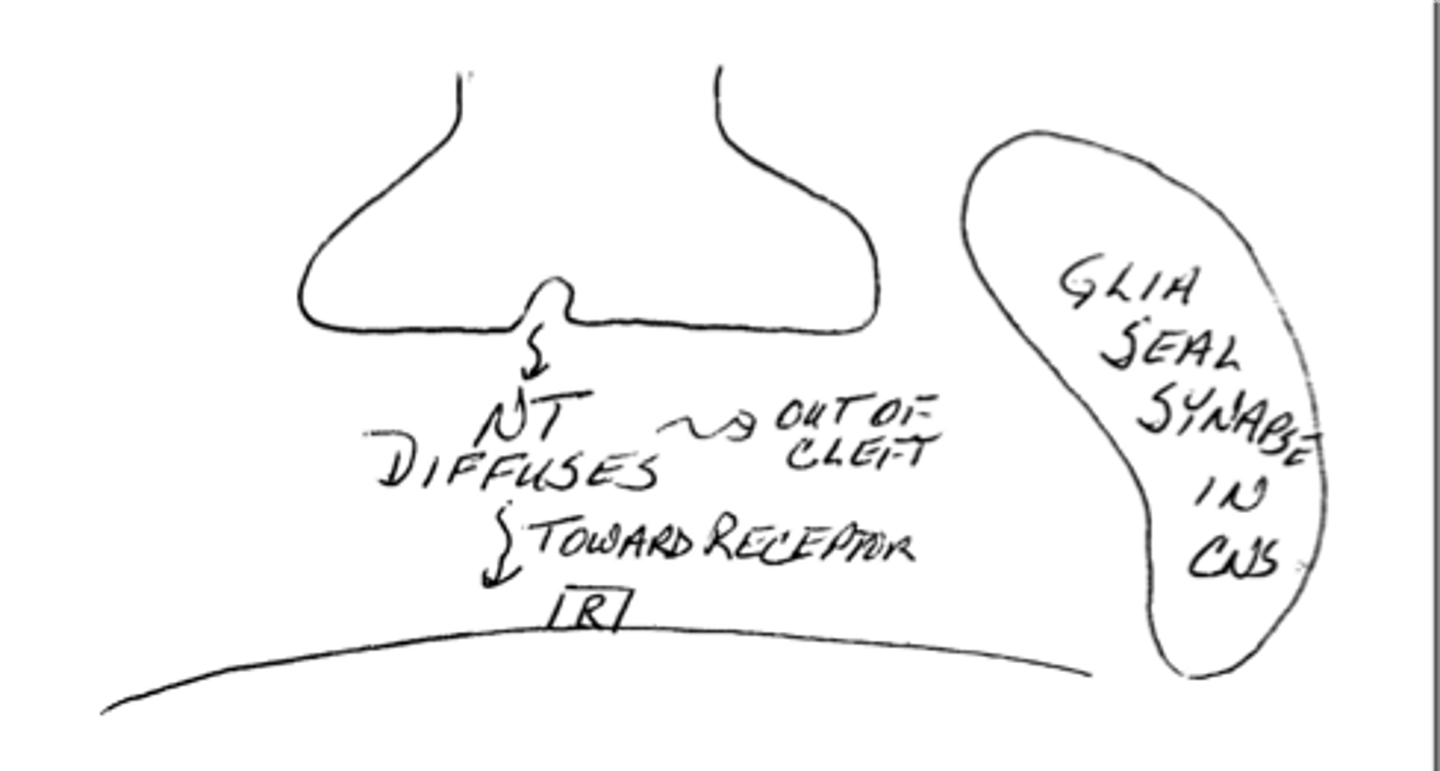
diffusion of some neurotransmitters is more common in the (CNS/PNS) synapses, however, it is less likely in (CNS/PNS) synapses because of a glial seal formed by the (oligodendrocytes/Schwann cells)
PNS, CNS, oligodendrocytes
PNS has a looser seal
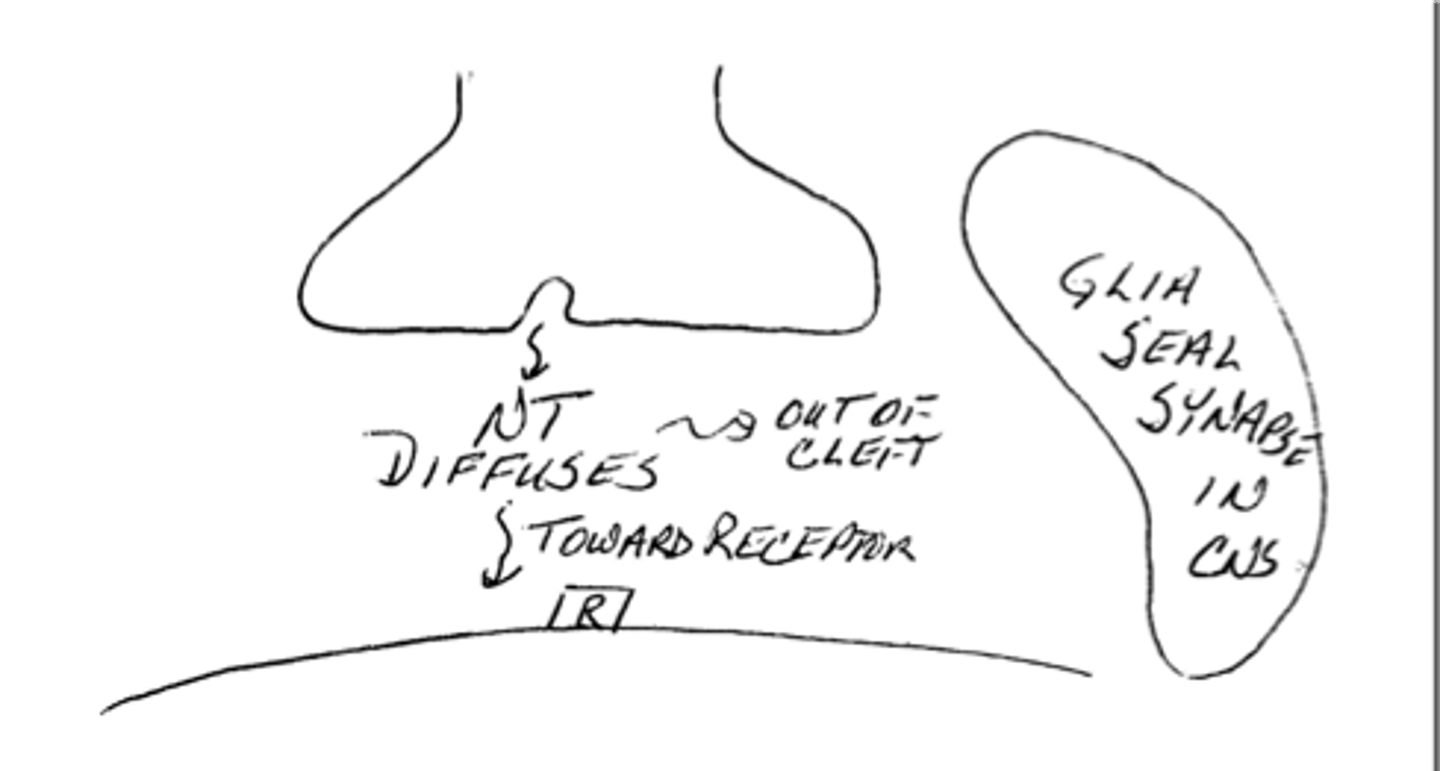
(t/f) neurotransmitters permanently bind to their receptors. once the effects are over, the ligand and receptor are both taken up by the cell and destroyed.
false; this connection is temporary to bring about an EPSP or IPSP (depending on the effector associated with the receptor)
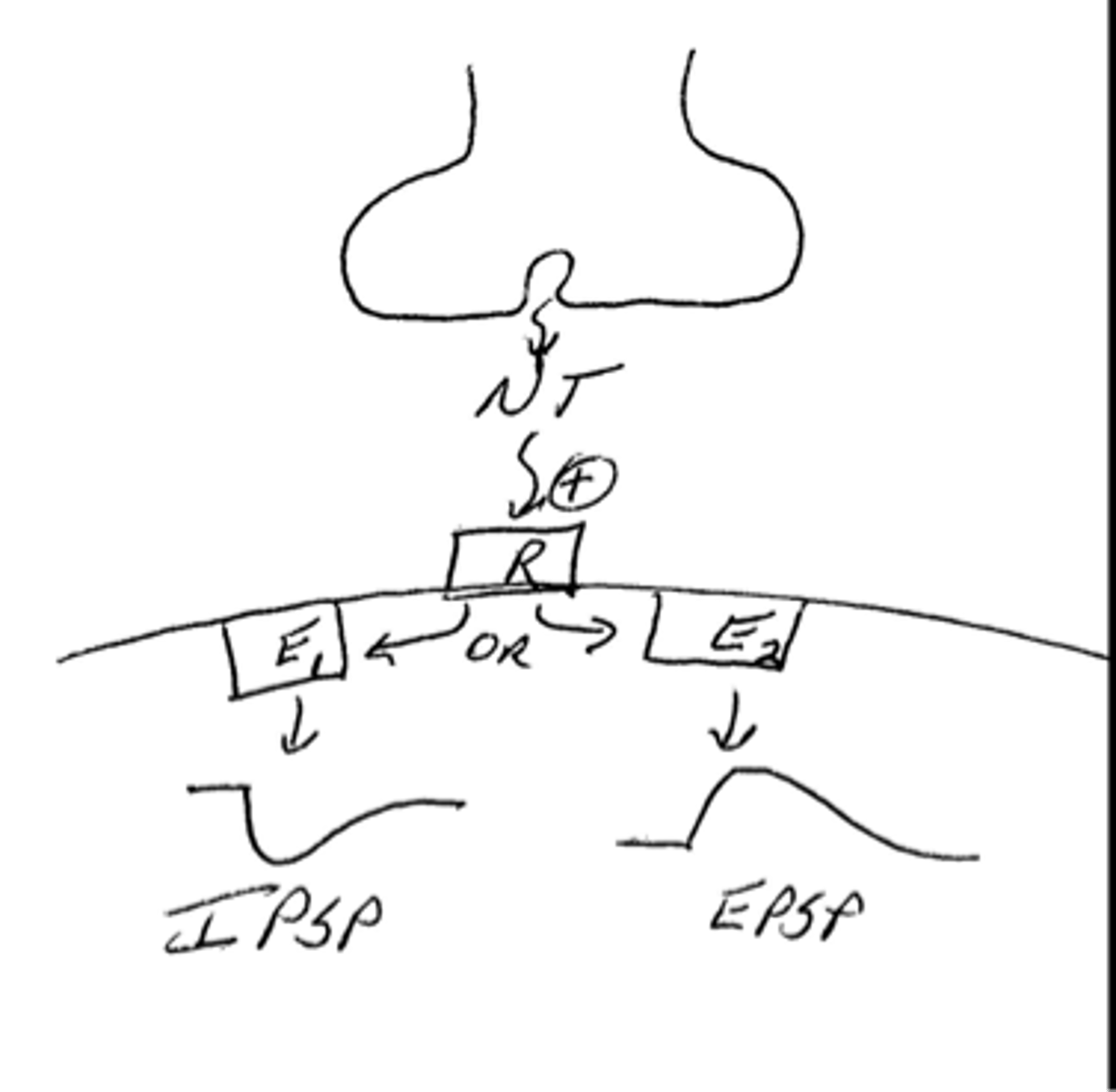
(t/f) an issue with neurotransmitters is that terminating the signal is difficult due to the low-affinity transport proteins found on the presynaptic membrane
false; high-affinity transport proteins are found on the presynaptic membrane and this allows the nerve terminal to recycle transmitter molecules by repackaging them in vesicles
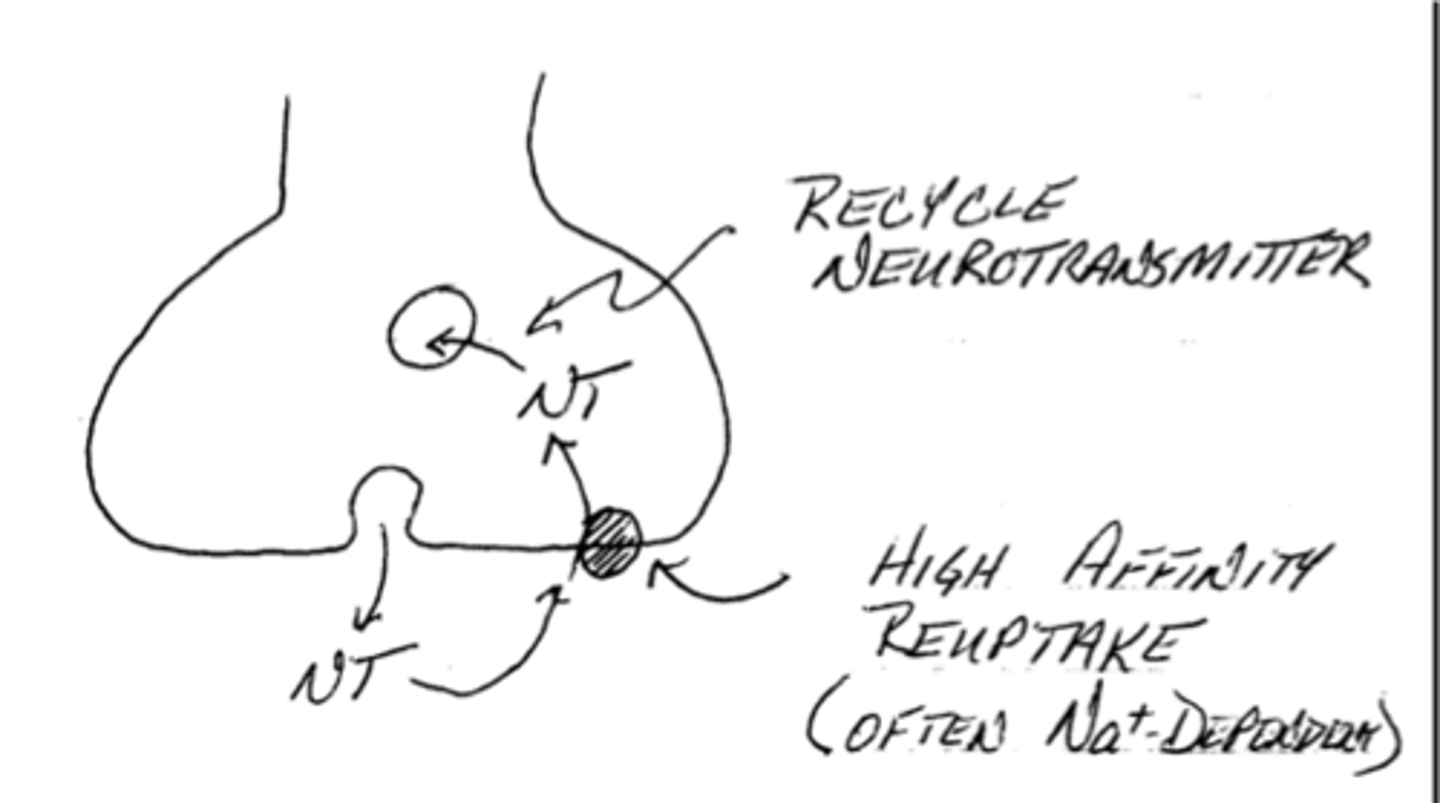
what are 2 ways to terminate a transmission?
1. reuptake of the neurotransmitter into a presynaptic terminal
2. catabolic enzymes found on the presynaptic or postsynaptic membrane that inactivate the neurotransmitters
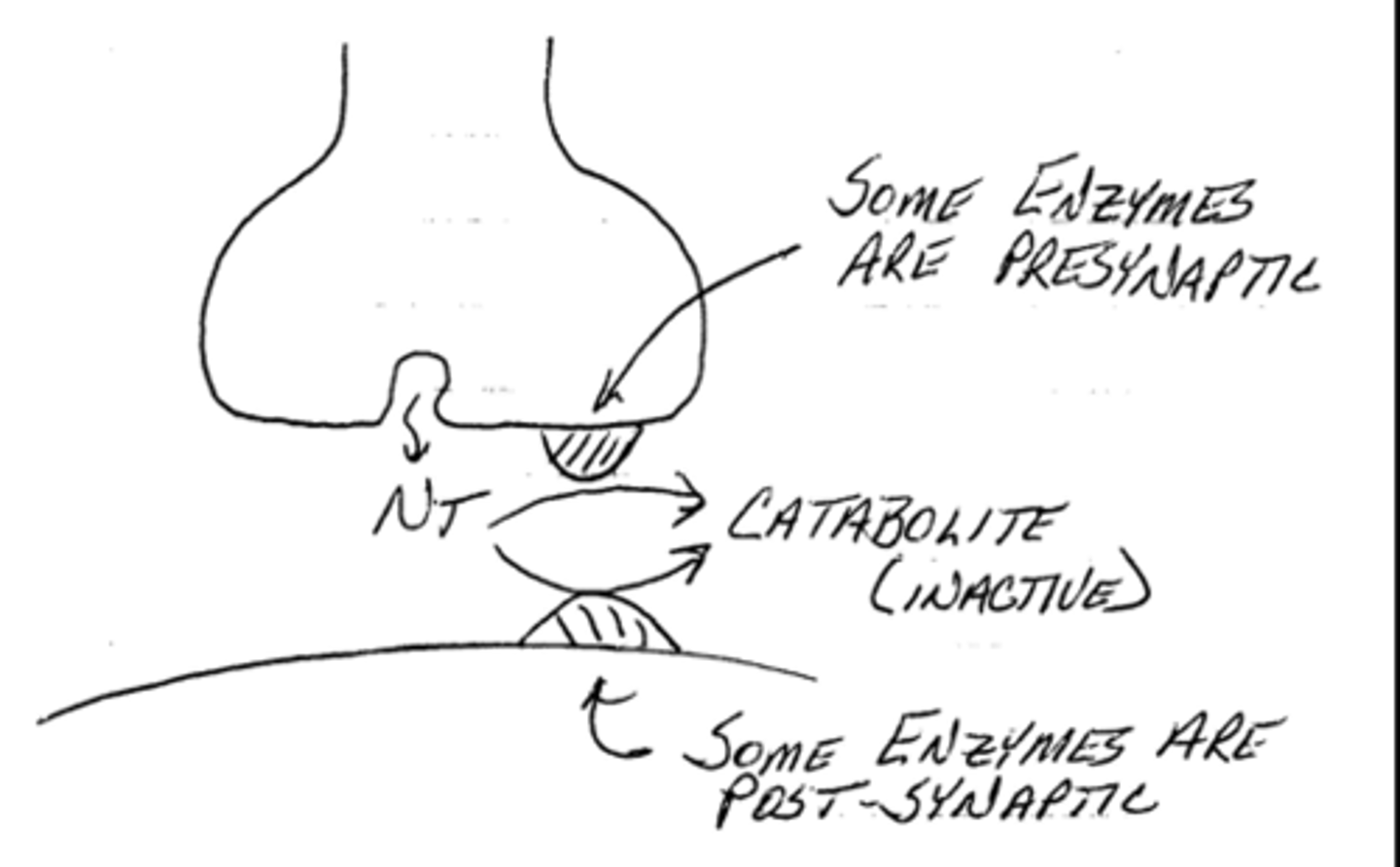
(t/f) transmitter molecules and the receptors for the transmitter molecules are intrinsically inhibitory or excitatory
false; they are not intrinsically inhibitory or excitatory, but instead the effector associated with the receptor is what makes the neurotransmitter inhibitory or excitatory
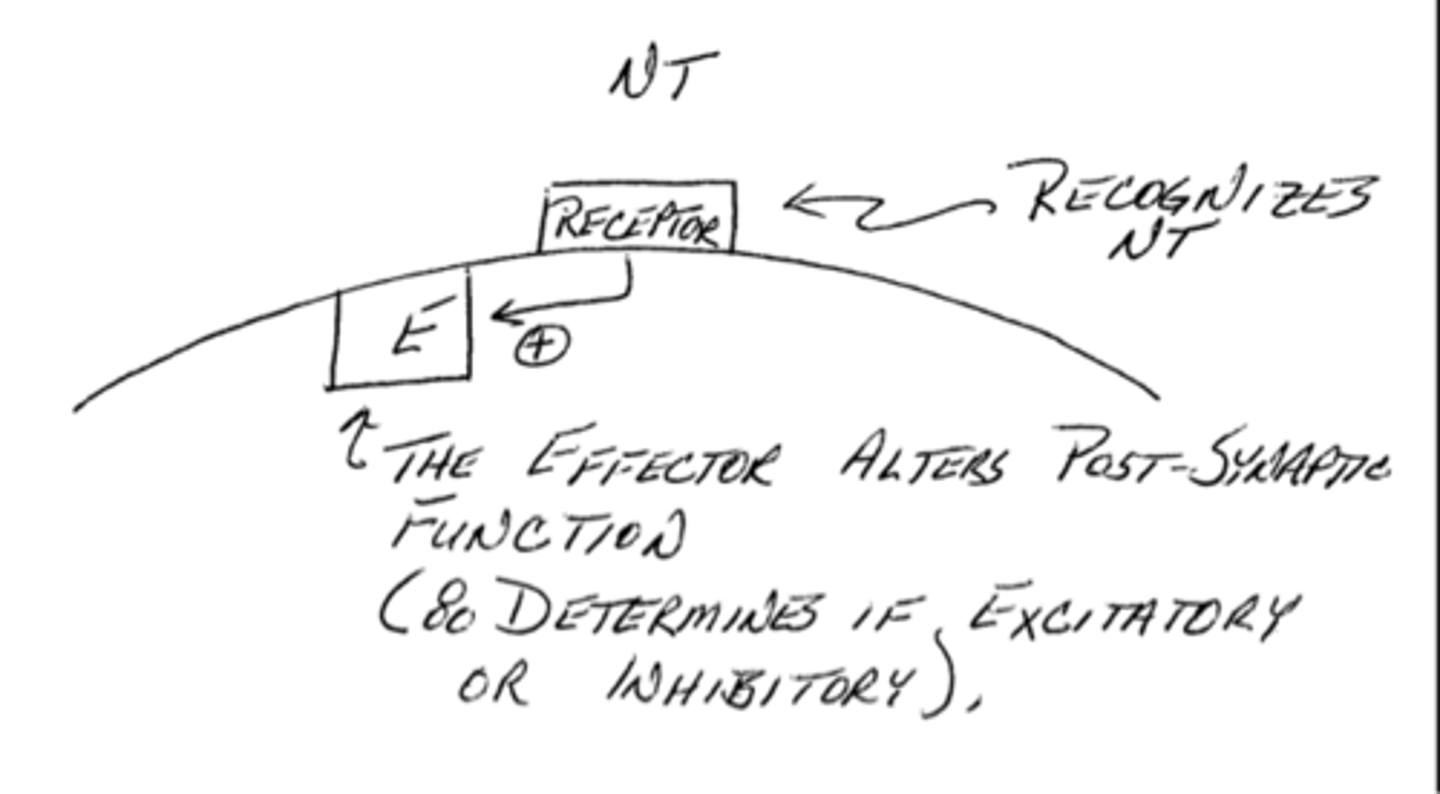
(t/f) acetylcholine may be excitatory at one synapse and inhibitory at another
true; this is based on the receptor-effector coupling on each target cell
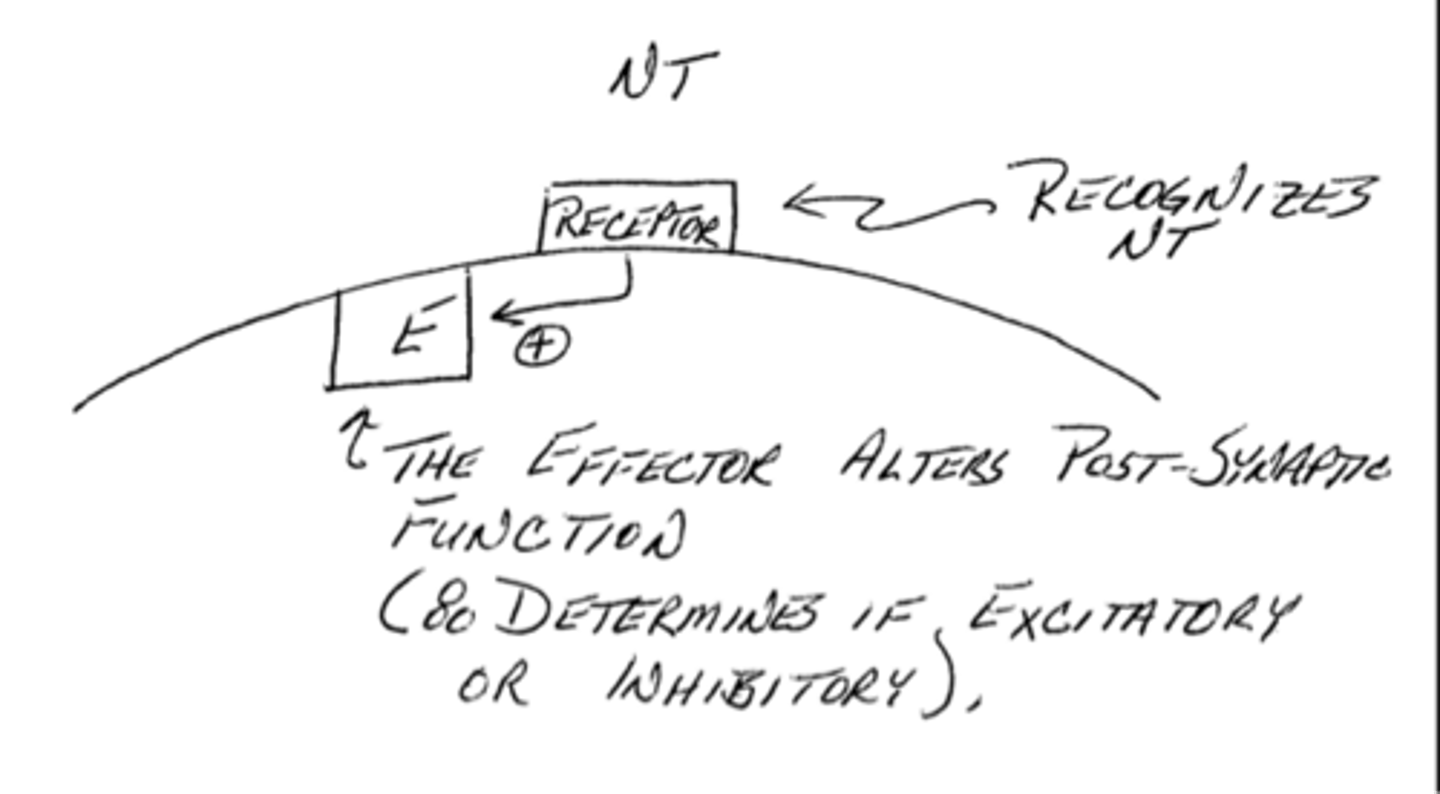
(t/f) effectors for a neurotransmitters will always be an ion channel that brings about a change in ionic permeability and result in either depolarization or hyperpolarization
false; these effectors may be ion channels but may also produce secondary messengers (like cAMP and cGMP)
Neurotransmitter effectors can be ion channels or enzymes/signaling pathways that produce secondary messengers, not just channels that directly change membrane potential.
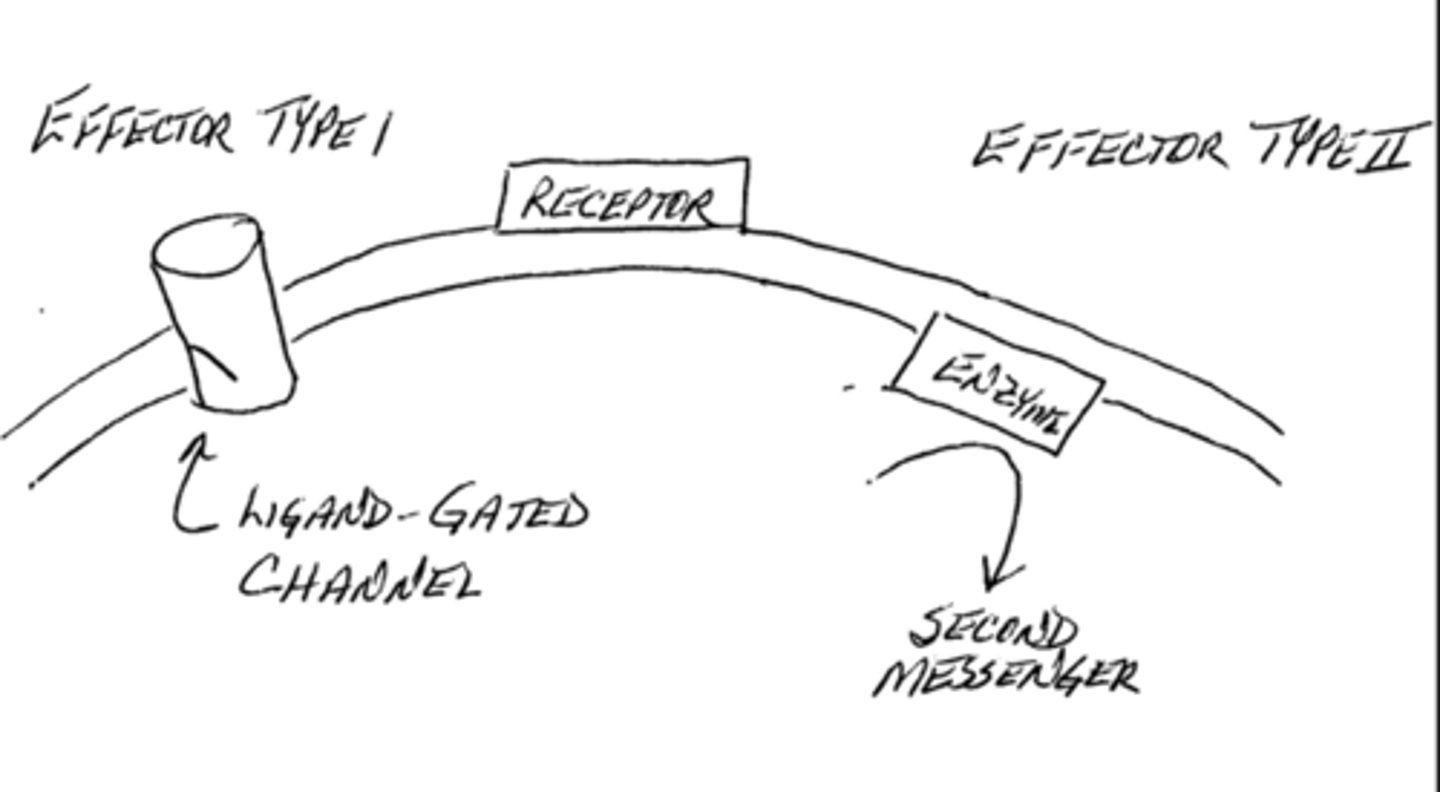
EPSP vs IPSP: effector that is an ion channel that allows both sodium and potassium to pass through the channel simultaneously
EPSP
EPSP vs IPSP: a simultaneous increase conductance for both sodium and potassium
EPSP
EPSP vs IPSP: the membrane potential moves toward the mean of the Nernst potential for sodium and the Nernst potential for potassium —> (-20 mV membrane potential)
EPSP
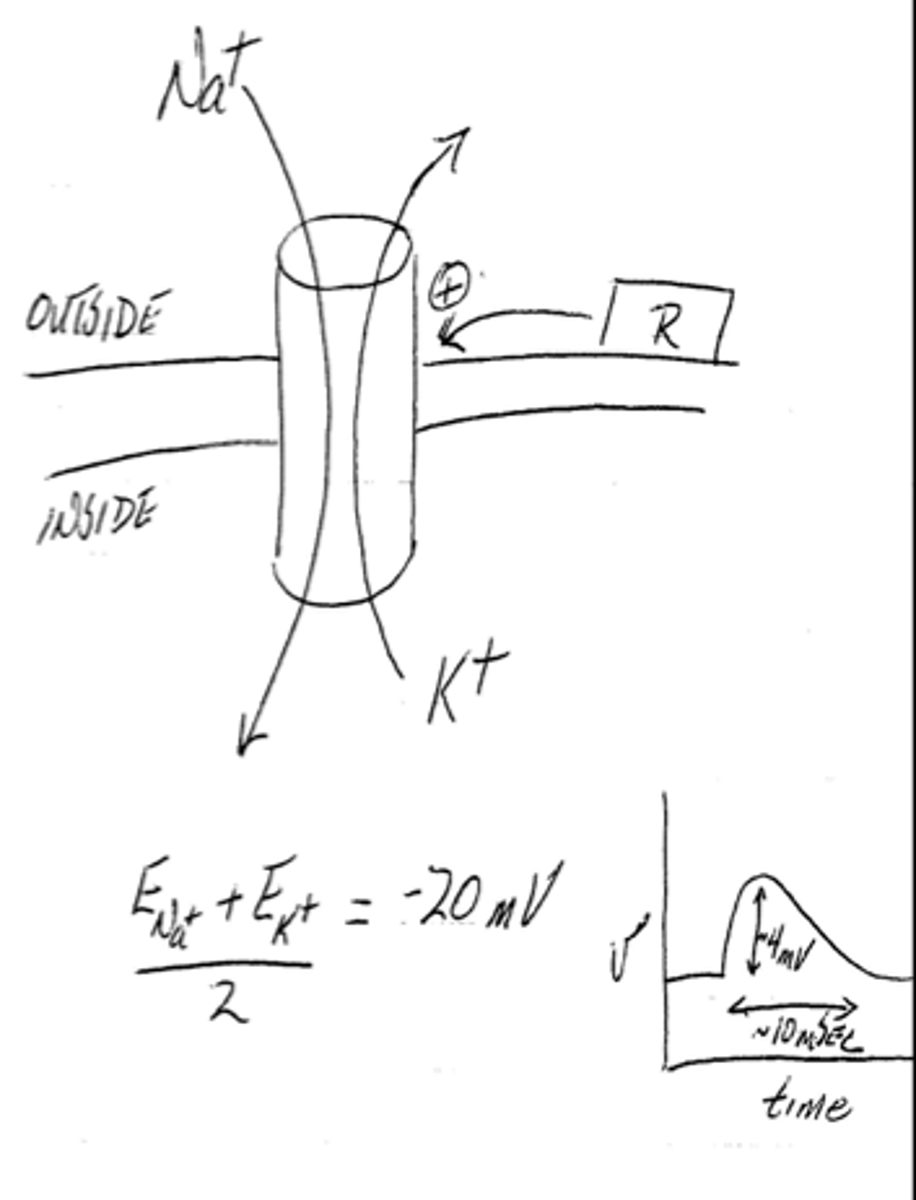
EPSP vs IPSP: -20 mV membrane potential
EPSP
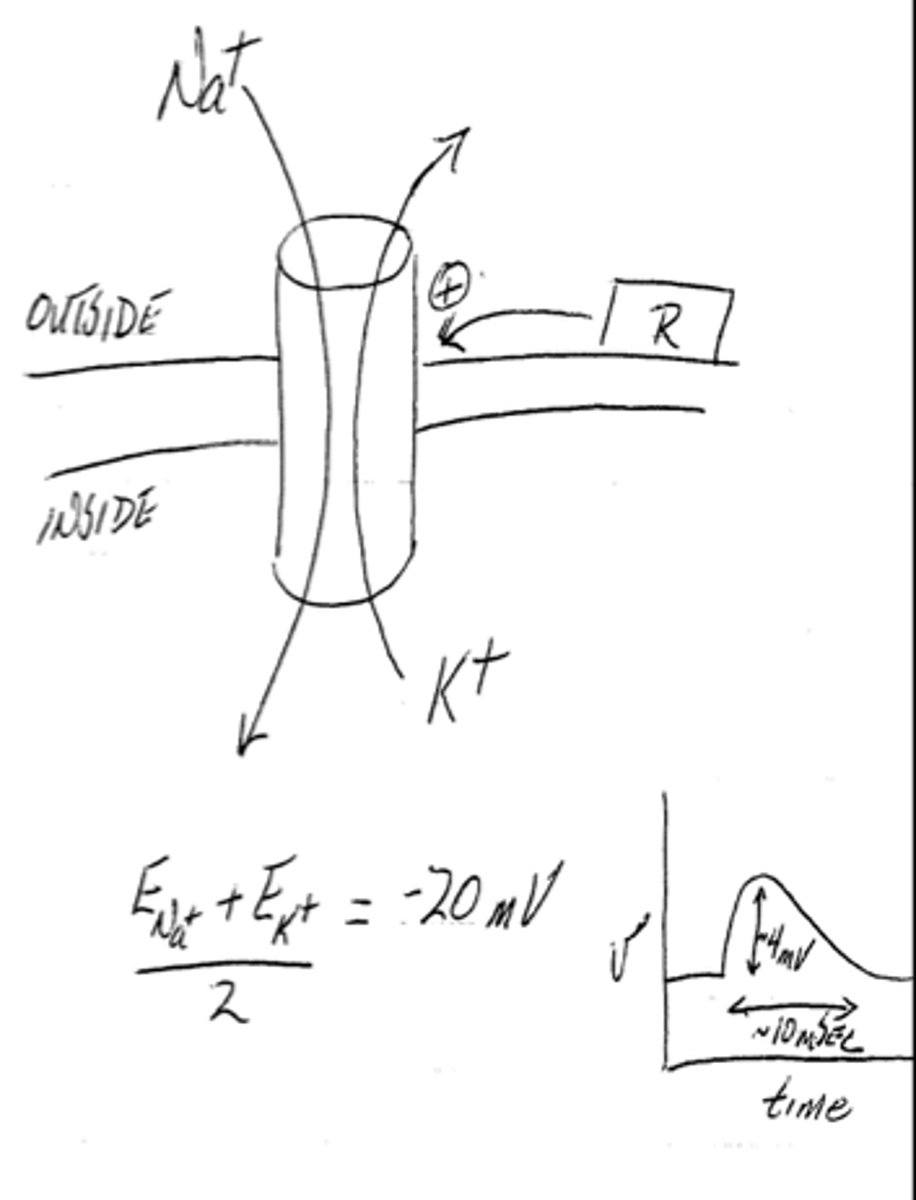
what happens to the membrane potential when ligand-gated excitatory channels open? what is a problem with this?
it depolarizes toward -20 mV from -70 mV and goes well beyond the threshold; these ligand-gated channels close very rapidly, so there is only time for a 5 mV depolarization
why is summation necessary for an EPSP action potential?
individual EPSPs are too small to reach threshold on their own so summation allows depolarizations to add up and trigger an action potential
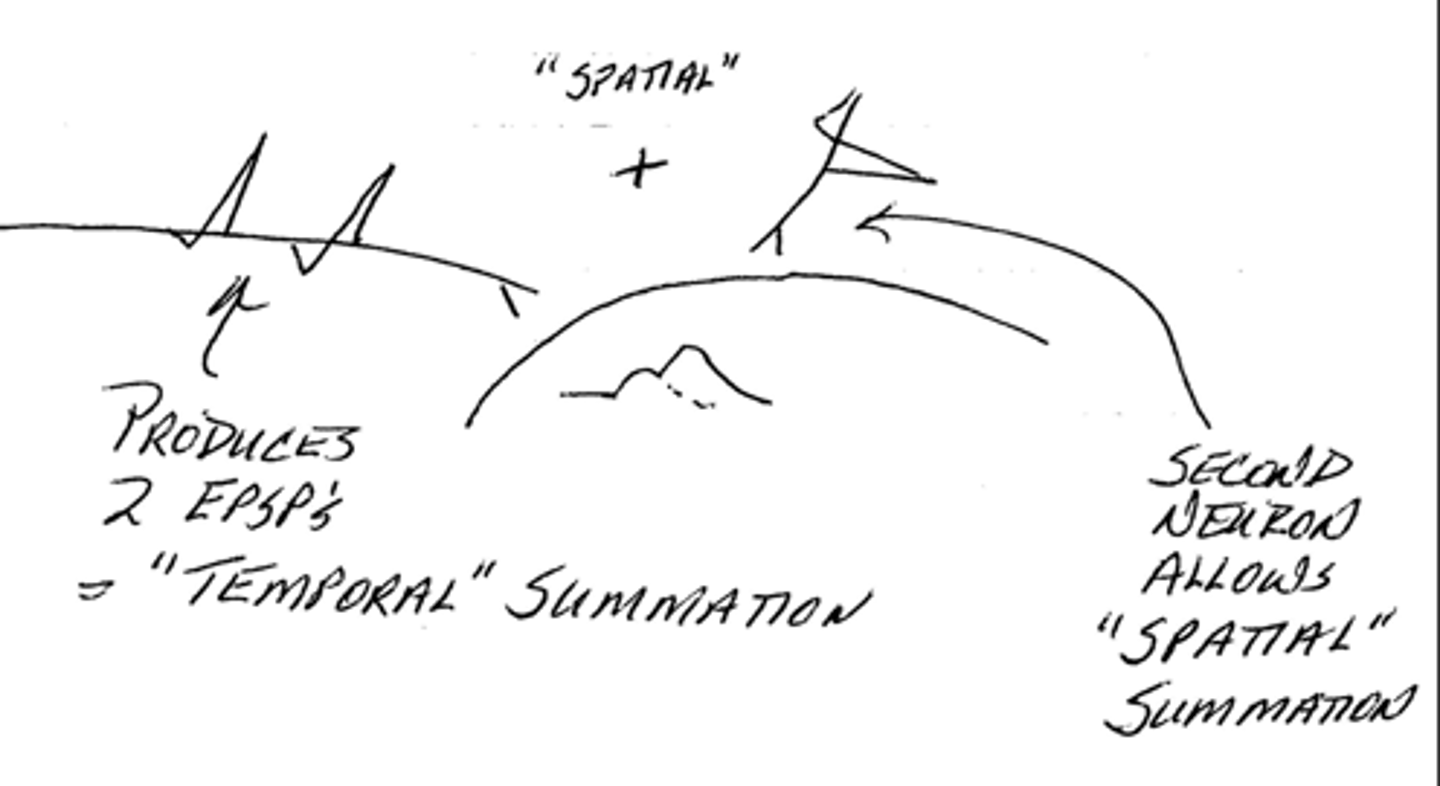
what are the 2 types of EPSP summations?
1. temporal summation: multiple EPSPs from the same synapse occur in rapid succession before the earlier ones decay, allowing them to add together
2. spatial summation: EPSPs from different synapses occur at the same time, combining to produce a larger depolarization
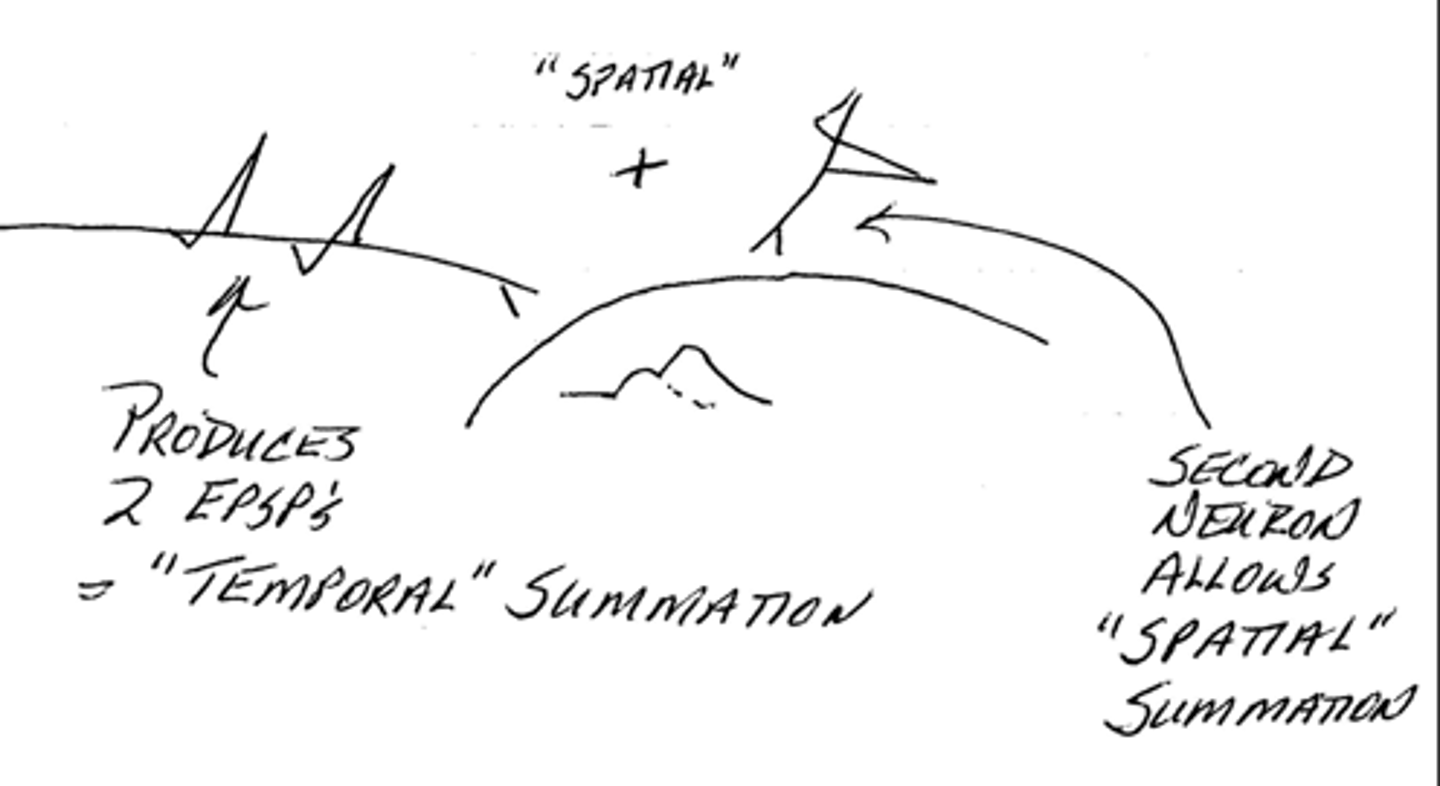
EPSP vs IPSP: ion channel is permeable to both chloride and potassium
IPSP
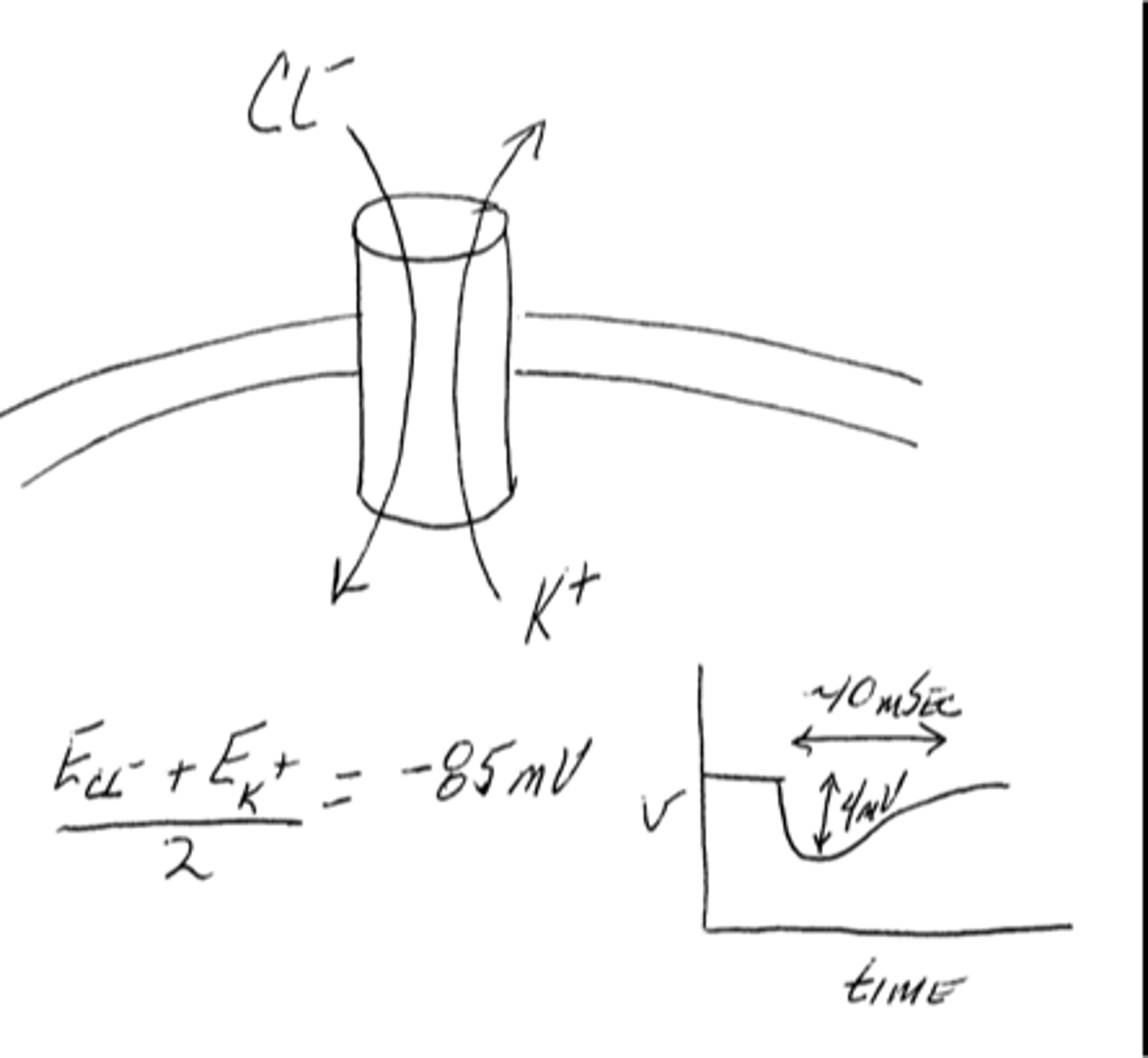
EPSP vs IPSP: membrane deflects toward the average of the Nernst potential of chloride and the Nernst potential of potassium —> -85 mV membrane potential
IPSP
EPSP vs IPSP: takes membrane potential further from threshold, making the post-synaptic neuron less likely to fire an action potentia
IPSP
(t/f) the net amount of excitation and inhibition determines whether or not the post-synaptic neuron fires an action potential
true
(t/f) a single EPSP is able to cancel out several IPSPs
false; a single IPSP is able to cancel out several EPSPs because EPSPs must travel a greater distance than IPSPs in order for summation to take place at the initial segment

EPSP vs IPSP: occur primarily on the cell soma
IPSP
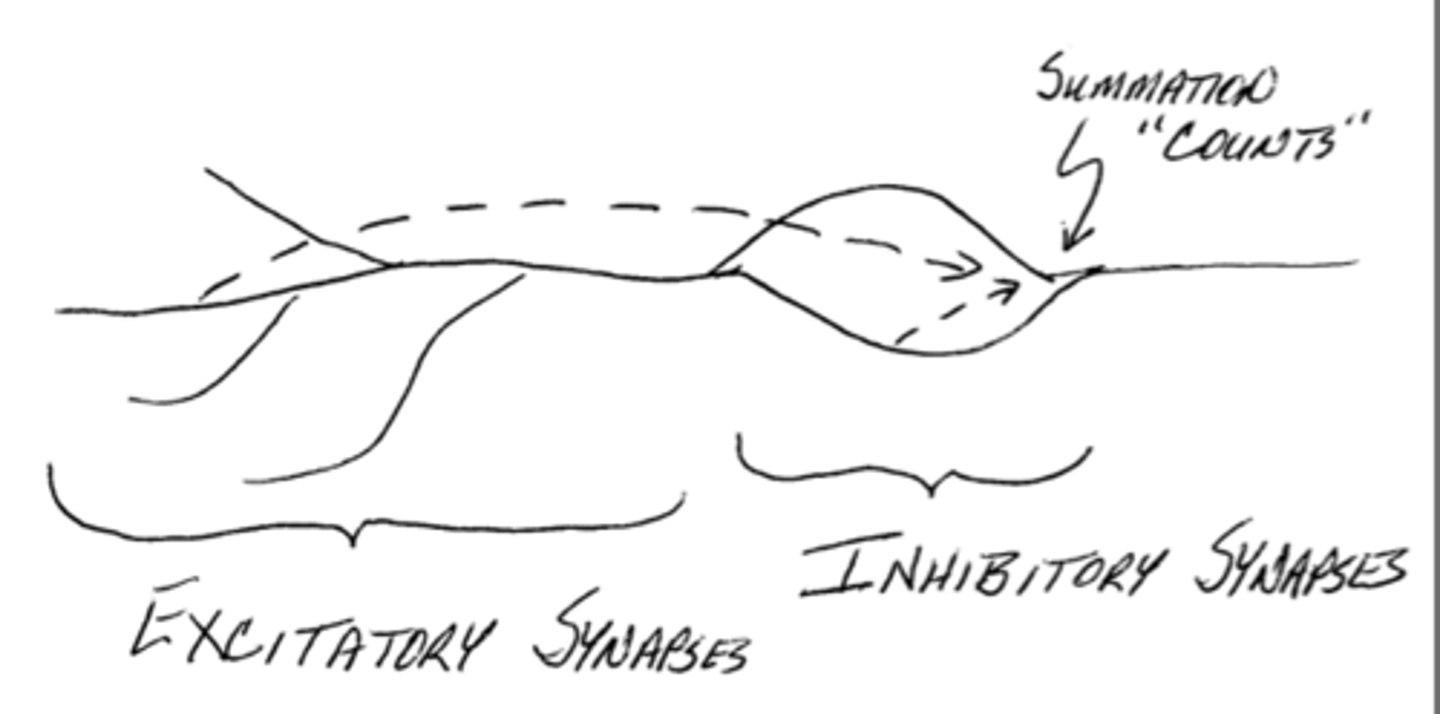
EPSP vs IPSP: occur primarily on the dendrites and dendritic spines
EPSP
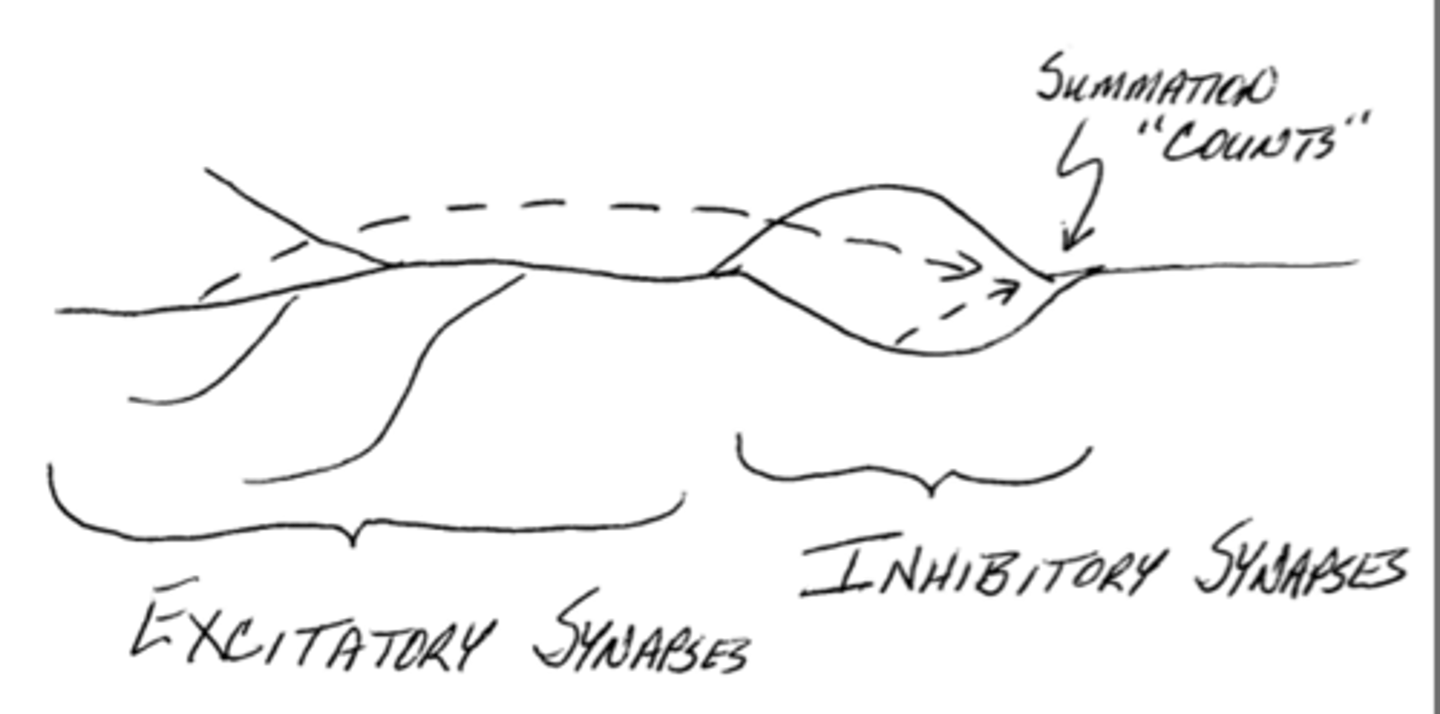
EPSP vs IPSP: occurs closer to initial segment
IPSP
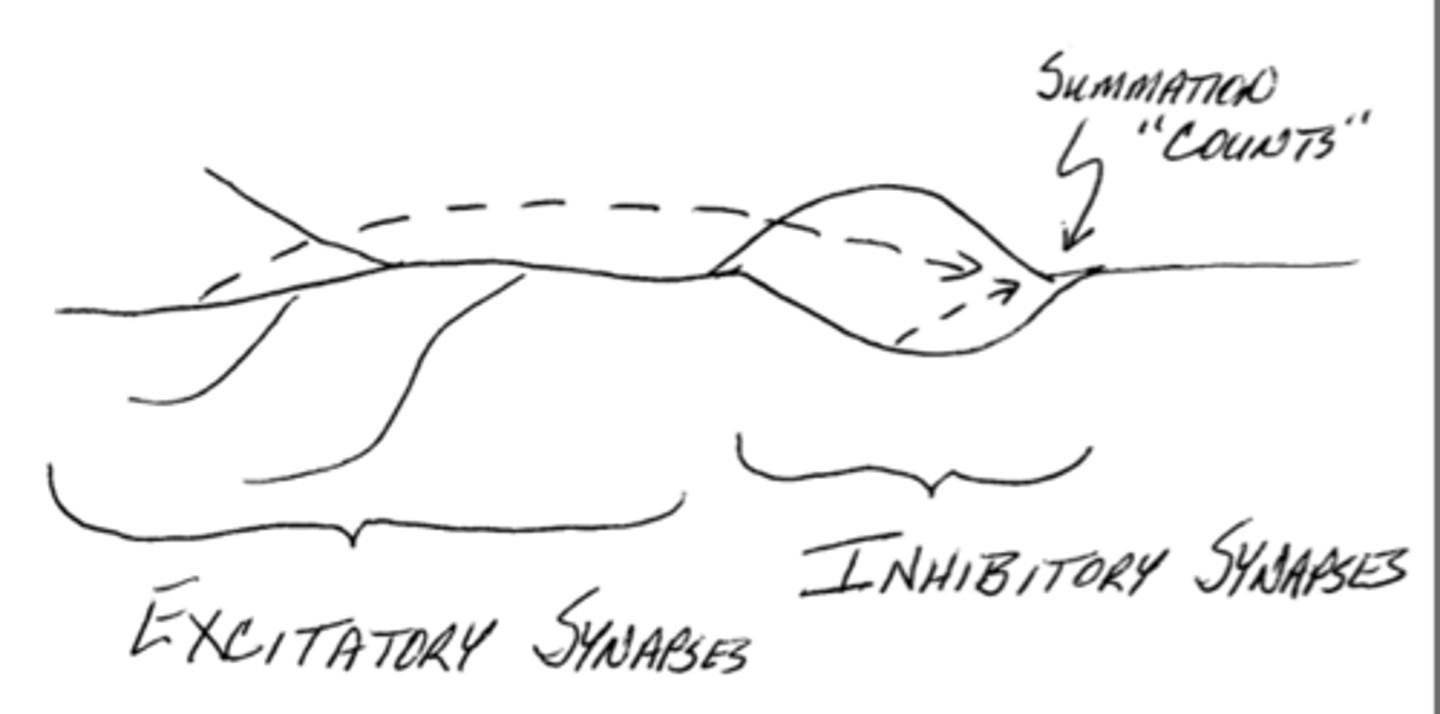
EPSP vs IPSP: occurs further from the initial segment
EPSP
